
The Rise and Fall of the Neoliberal Order: America and the World in the Free Market Era
by
Gary Gerstle
Published 14 Oct 2022
He met his future wife, Heidi (Adelaide Elizabeth Farrell), while both were civil rights and labor activists in the 1940s. See Jill Leovy, “Alvin Toffler, Author of 1970 Bestseller ‘Future Shock,’ Dies at 87,” Los Angeles Times, June 29, 2016, https://www.latimes.com/local/obituaries/la-me-alvin-toffler-20160629-snap-story.html, accessed July 29, 2021; Kenneth Schneider, “Alvin Toffler, Author of ‘Future Shock,’ Dies at 87,” New York Times, June 29, 2021, https://www.nytimes.com/2016/06/30/books/alvin-toffler-author-of-future-shock-dies-at-87.html, accessed July 29, 2021; David Henry, “Alvin Toffler, Author of BestSelling ‘Future Shock’ and ‘The Third Wave,’ Dies at 87,” Washington Post, June 29, 2016, https://www.washingtonpost.com/business/alvin-toffler-author-of-bestselling-future-shock-and-the-third-wave-dies-at-87/2016/06/29/0d63748c-3e09-11e6-80bc-d06711fd2125_story.html, accessed August 10, 2021.
…
Baer, Reinventing Democrats: The Politics of Liberalism from Reagan to Clinton (Lawrence: University of Kansas Press, 2000; Al From, The New Democrats and the Return to Power (New York: Palgrave Macmillan, 2013); Michael Kazin, What It Took to Win: A History of the Democratic Party (New York: Farrar, Straus and Giroux, 2022); Iwan Morgan, “Jimmy Carter, Bill Clinton, and the New Democratic Economics,” Historical Journal 47 (2004), 1015–1039; Lily Geismer, Don’t Blame Us: Suburban Liberals and the Transformation of the Democratic Party (Princeton, NJ: Princeton University Press, 2015). 43.Kruse and Zelizer, Fault Lines, 232; Margaret O’Mara, The Code: Silicon Valley and the Remaking of America (New York: Penguin Press, 2019). 44.President William Jefferson Clinton, “2000 State of the Union Address,” January 27, 2000, reprinted in the New York Times, January 28, 2000, https://www.nytimes.com/2000/01/28/us/state-union-president-clinton-state-union-strongest-it-has-ever-been.html, accessed July 14, 2020. 45.O’Mara, The Code; Fred Turner, From Counterculture to Cyberculture: Stewart Brand, the Whole Earth Network, and the Rise of Digital Utopianism (Chicago, IL: University of Chicago Press, 2008). 46.Alvin and Heidi Toffler had outlined their theory of the three waves in their bestselling 1980 book, Third Wave (New York: Bantam Books, 1980). Alvin Toffler had risen to prominence with his previous book Future Shock (New York: Random House, 1970). 47.Esther Dyson, George Gilder, George Keyworth, and Alvin Toffler, “Cyberspace and the American Dream: A Magna Carta for the Knowledge Age,” http://www.pff.org/issues-pubs/futureinsights/fi1.2magnacarta.html, accessed July 29, 2021. 48.Dyson et al., “Cyberspace and the American Dream.” 49.Dyson et al., “Cyberspace and the American Dream.” Alvin Toffler had been born to Jewish immigrants in New York in 1928 and was exposed across his childhood and adolescence to leftist ideas circulating in his extended family milieu.
…
Four cyberspace enthusiasts—Esther Dyson, George Gilder, George Keyworth, and Alvin Toffler—encased their IT vision in a manifesto, “Cyberspace and the American Dream: A Magna Carta for the Knowledge Age,” which they circulated in 1994. The title of the manifesto said it all: Cyberspace represented an opportunity to renew “the American Dream” and to adapt ancient and revered traditions of Anglo-American liberty for a new century. The manifesto was utopian in its conviction that the cybernetic revolution represented a chance to start the world anew and to free humanity from past shackles. Drawing on the work of the acclaimed futurist in their ranks, Alvin Toffler, it framed the revolution in terms of “Third Wave” innovation.46 The First Wave had made land and labor “the main ‘factors of production’; the Second Wave had ‘massified’ [labor] around machines and larger industries.
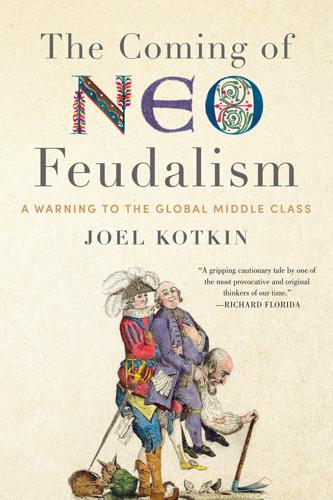
The Coming of Neo-Feudalism: A Warning to the Global Middle Class
by
Joel Kotkin
Published 11 May 2020
Reporting from the ground—particularly in the United States, Australia, the UK, Singapore, India, and China—have done much to shape this book. But I have taken inspiration also from thinking about what the great analysts of the past—Alexis de Tocqueville, Karl Marx, Max Weber, Daniel Bell, Taichi Sakaiya, Alvin Toffler—would have made of the current situation. The future that appears on the horizon is not one that I desire for any country, or for my own children. This book is meant to rally those who cherish the independence, freedom, and possibilities for upward mobility that have been the hallmarks of liberal democracy over the past few centuries.
…
This vision rests on a faith in—or an obsession with—technological determinism, in which new technology is our evolutionary successor.19 But is this what most people want the future to be? The Cultural Revolution What the tech oligarchs are already doing to control the culture should raise alarm. The IT revolution once appeared to be launching a more democratic era in communications, with the “de-massified media” that Alvin Toffler optimistically predicted. But what looked like a more diverse and open media world, where anyone could be a reporter or reach an audience, is turning into one where a very few companies control the information pipelines.20 Nearly two-thirds of U.S. adults now get their news through Facebook or Google.21 Millennials in both the United States and the UK are almost three times as likely to get their information from these platforms as from print, television, or radio.22 The power of the tech oligarchy has grown at a time when print publishing and the firms that have dominated it are experiencing a secular and probably irreversible decline.
…
After all, nearly 40 percent of private entrepreneurs also belong to the Communist Party.2 In the West, entrepreneurs have historically tended to be a force for liberalization and for limiting the power of entrenched aristocracies and clerical elites, since “commerce desires to be free,” in the words of the seventeenth-century Dutch economist Peter de la Court.3 By contrast, leading oligarchs in today’s tech and finance sectors are often inclined to support the heavy-handed “progressive” policies embraced by the dominant elements of the clerisy—as long as it doesn’t threaten their own fortunes.4 Thus the real cultural power lies in the “Brahmin left,” to use Thomas Piketty’s term.5 “Post-Economic Goals” Alvin Toffler predicted almost half a century ago that growing affluence would result in replacing the profit motive with more aesthetic goals, a quest for self-fulfillment, or unbridled hedonism. “Affluence serves as a base from which men begin to strive for post-economic goals,” he wrote.6 The “woke” values of the upper classes are an example of such “post-economic” goals.

The Survival of the City: Human Flourishing in an Age of Isolation
by
Edward Glaeser
and
David Cutler
Published 14 Sep 2021
In the 1970s, when cities like New York tried to tax companies and the rich, those taxpayers fled to lower tax locations. The downward spiral discussed in our introduction, where decline begets decline, seemed to foretell the future of cities. That is the backdrop for Alvin Toffler’s 1980 prognostication about the rise of telecommuting. Alvin Toffler and the Triumph of Telecommuting Alvin Toffler was a true scion of New York City. His father made furs, the products of the clothing industry that go back to the beaver pelts bought by the Dutch during the early seventeenth century. Toffler met his wife, Heidi, who deserves much of the credit for his writing, at New York University.
…
more than 68 percent: Kneebone, “Job Sprawl Revisited: The Changing Geography of Metropolitan Employment.” garment sector: Glaeser, Triumph of the City, 41. 140,000 workers making women’s outerwear: Hum, “Mapping Global Production in New York City’s Garment Industry: The Role of Sunset Park, Brooklyn’s Immigrant Economy.” Ralph Lauren: “Ralph Lauren,” Biography. Alvin Toffler: Schneider, “Alvin Toffler, Author of ‘Future Shock,’ Dies at 87.” “dizzying disorientation”: Toffler, Future Shock, 11. “the only remedy for the phenomenon of future shock”: Toffler, “The Future as a Way of Life.” “trend towards residential renting”: Toffler, Future Shock, 64. 56 percent in 1940 to 37 percent in 1970: Data from www2.census.gov/programs-surveys/demo/tables/geographic-mobility/time-series/historic/tab-a-1.xls.
…
Schmidt, William H., and Richard T. Houang. “Curricular Coherence and the Common Core State Standards for Mathematics.” Educational Researcher 41, no. 8 (November 2012): 294–308. https://doi.org/10.3102/0013189X12464517. Schneider, Keith. “Alvin Toffler, Author of ‘Future Shock,’ Dies at 87.” The New York Times, June 29, 2016. www.nytimes.com/2016/06/30/books/alvin-toffler-author-of-future-shock-dies-at-87.html. Schoen, Cathy, and Michelle M. Doty. “Inequities in Access to Medical Care in Five Countries: Findings from the 2001 Commonwealth Fund International Health Policy Survey.” Health Policy 67, no. 3 (March 2004): 309-22. https://doi.org/10.1016/j.healthpol.2003.09.006.
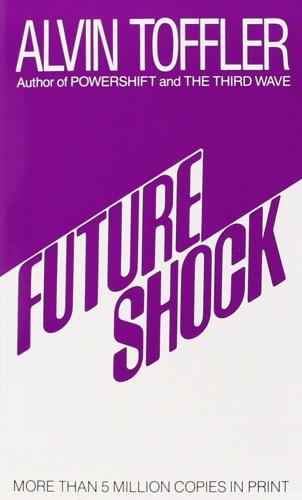
Future Shock
by
Alvin Toffler
Published 1 Jun 1984
Robert Rimmer, author of The Harrad Experiment: "A magnificent job ... Must reading." John Diebold: "For those who want to understand the social and psychological implications of the technological revolution, this is an incomparable book." WALL STREET JOURNAL: "Explosive ... Brilliantly formulated." LONDON DAILY EXPRESS: "Alvin Toffler has sent something of a shock-wave through Western society." LE FIGARO: "The best study of our times that I know ... Of all the books that I have read in the last 20 years, it is by far the one that has taught me the most." THE TIMES OF INDIA: "To the elite ... who often get committed to age-old institutions or material goals alone, let Toffler's FUTURE SHOCK be a lesson and a warning."
…
The book is more than a book, and it will do more than send reviewers raving ... It is a spectacular outcrop of a formidable, organized intellectual effort ... For the first time in history scientists are marrying the insights of artists, poets, dramatists, and novelists to statistical analysis and operational research. The two cultures have met and are being merged. Alvin Toffler is one of the first exhilarating, liberating results." CHRISTIAN SCIENCE MONITOR: "Packed with ideas, explanations, constructive suggestions ... Revealing, exciting, encouraging, brilliant." NEWSWEEK: "In the risky business of social and cultural criticism, there appears an occasional book that manages—through some happy combination of accident and insight—to shape our perceptions of its times.
…
NEWSWEEK: "In the risky business of social and cultural criticism, there appears an occasional book that manages—through some happy combination of accident and insight—to shape our perceptions of its times. One thinks of America in the 1950s, for example, largely in terms of David Riesman's The Lonely Crowd and John Kenneth Galbraith's The Affluent Society, while Michael Harrington's The Other America helped focus the concerns of the early 1960s. And now Alvin Toffler's immensely readable yet disquieting study may serve the same purpose for our own increasingly volatile world: even before reading the book, one is ready to acknowledge the point of the title—that we suffer from 'future shock.'" This low-priced Bantam Book has been completely reset in a type face designed for easy reading, and was printed from new plates.

The New Class Conflict
by
Joel Kotkin
Published 31 Aug 2014
The bulk of the other new rich either inherited their fortunes or are drawn from the ranks of the Russian oligarchs.24 The Favored .01 Percent Great wealth and high status, particularly at a young age, often persuade people that they know best about the future and about how society should be governed. “One needs imagination to confront a revolution,” observed Alvin Toffler.25 Twitter founder Jack Dorsey, a 37-year-old resident of San Francisco, announced in 2013 that he aspires to become mayor—of New York. He hopes to follow in the footsteps of billionaire Michael Bloomberg. Like his fellow Oligarch, he maintains that his business expertise qualifies him to run the nation’s biggest city, even if he hasn’t quite gotten around to living there.26 The tech Oligarch’s ascendency has made them feel somehow different—and superior.
…
By 1990, the Valley accounted for 39 of the nation’s fastest growing electronics companies, compared to just four along Boston’s Route 128. Over the ensuing decade, Valley firms, largely through the application of software, also overcame what had once been considered insurmountable competition from Japan.45 The great hope promised by this emerging, post-industrial information economy was perhaps best stated by futurist Alvin Toffler. He distinguished between bureaucratic, top-down “Second Wave” industrial firms—which still remain powerful in their own right—and the flatter, more dispersed, and fundamentally less hierarchical “Third Wave” firms. The decentralization of technology, allowing people to communicate without going through a centralized computer, Toffler reasoned, would weaken the power of “Big Brother,” promoting instead the decentralization of power.46 Being simply the medium of the message, software companies could not control it, it was believed, and few considered how such companies’ activities could prove harmful to the consumer.47 These new Third Wave companies, noted one journalist, were seen as “wildly productive but humane,” headed by entrepreneurs who embraced an “egalitarian” ethos that saw senior executives hobnobbing with janitors in an almost comradely fashion.
…
Indeed, despite all the talk of increased mass transit usage, the percentage of Americans working at home has grown 1.5 times faster over the past decade; there are now more telecommuters than people who take mass transit to work in 38 out of the 52 U.S. metropolitan areas.88 This emergence of the “electronic cottage,” to borrow Alvin Toffler’s phrase, reflects the potential for democratization in the information age. It also represents an enormous environmental bonus, as it greatly reduces both energy use and commute times. Indeed, a study by Global Workplace Analytics finds increased telecommuting could reduce carbon emissions by over 51 million metric tons a year—the equivalent of taking all of greater New York’s commuters off the road.

The Code: Silicon Valley and the Remaking of America
by
Margaret O'Mara
Published 8 Jul 2019
Schenker, “A Different Scenario: Personal Computers in the 80’s,” InfoWorld 2, no. 6 (April 14, 1980): 11, Box 1, Liza Loop Papers, M1141, SU; Peter J. Schuyten, “Subculture of Silicon Technology,” The New York Times, May 10, 1979, D2. 21. McKenna, The Regis Touch, xi. 22. Alvin Toffler, Future Shock (New York: Random House, 1970), 29; Jobs quoted in Mills, “The Third Wave.” 23. Christian Williams, “Future Shock Revisited: Alvin Toffler’s ‘Wave,’” The Washington Post, March 31, 1980, B1. 24. “Tandy Radio Shack Assaults the Small Computer Market,” The Rosen Electronics Letter 80, no. 14 (August 8, 1980), Catalog No. 102661121, CHM; McKenna, The Regis Touch, 62. 25.
…
The machine seemed to be winning. When that happens, Ellul concluded darkly, “everything will be ordered, and the strains of human passions will be lost amid the chromium gleam.”19 Perhaps no author captured the information-age zeitgeist more thoroughly than a journalist and self-appointed futurist named Alvin Toffler. The hyperkinetic New Yorker had started his adult life as a Marxist civil rights activist, which he followed with several years experiencing the workingman’s life as a welder in Cleveland. Eventually he moved into journalism, ultimately leaving Marx behind to become an editor at the buoyantly capitalist Fortune magazine.
…
(One called it “a high school term paper gone berserk.”) Style aside, the book’s dystopic overtones were certainly a lot to swallow; Toffler’s own mother remarked: “if that’s the way it’s going to be, I don’t want to be here.” Nonetheless, Future Shock ultimately sold five million copies, and made Alvin Toffler into an inescapable seer of the information age.22 For all its wilder ideas and overstuffed prose, Toffler’s book was stunningly prescient. He predicted that technology would break down large bureaucracies into an “ad-hocracy” of many smaller, more agile units that could grow and shrink on demand.
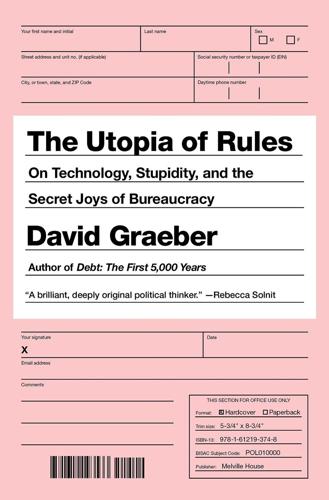
Bureaucracy
by
David Graeber
Published 3 Feb 2015
.: Space policy institute, George Washington University, 1988), or Linda Billings, “Ideology, Advocacy, and Spaceflight: Evolution of a Cultural Narrative” in The Societal Impact of Spaceflight, Stephen J. Dick and Roger D. Launius, eds. (Washington, D.C.: NASA, 2009). 83. Alvin Toffler, Future Shock (New York: Random House, 1970). 84. In this case, too, there’s a Soviet equivalent: the Tupolev TU-144, which was actually the first supersonic passenger plane, and which first flew a few months before the Concorde in 1968, but was abandoned for commercial purposes in 1983. 85. Source: www.foundersfund.com/uploads/ff_manifesto.pdf. 86. Alvin Toffler, The Third Wave (New York: Bantam Books, 1980). 87. Toffler’s own politics are slightly more ambiguous, but not much.
…
But since then, most apparent technological advances have largely taken the form of either clever new ways of combining existing technologies (as in the space race), or new ways to put existing technologies to consumer use (the most famous example here is television, invented in 1926, but only mass-produced in the late forties and early fifties, in a self-conscious effort to create new consumer demand to ensure the American economy didn’t slip back into depression). Yet the space race helped convey the notion that this was an age of remarkable advances, and the predominant popular impression during the sixties was that the pace of technological change was speeding up in terrifying, uncontrollable ways. Alvin Toffler’s 1970 breakaway bestseller Future Shock can be seen as a kind of high-water mark of this line of thought. In retrospect, it’s a fascinating and revealing book.83 Toffler argued that almost all of the social problems of the 1960s could be traced back to the increasing pace of technological change.
…
Before the success of Future Shock, he had been known mainly as a business journalist, whose greatest claim to fame was probably that he had interviewed Ayn Rand for Playboy. Like most conservatives, he pays lip service to women’s equality as an abstract principle, but never mentions actual feminists or feminist issues except to criticize them: for a typical example, see his Revolutionary Wealth: How It Will Be Created and How It Will Change Our Lives, Alvin Toffler and Heidi Toffler (New York: Doubleday, 2006), pp. 132–33. It is certainly curious that both Toffler and Gilder are so obsessed with the threat to motherhood: it’s as if both are basing their politics on an opposition to the ideas of Shulamith Firestone, long before Firestone herself had actually appeared on the scene. 88.
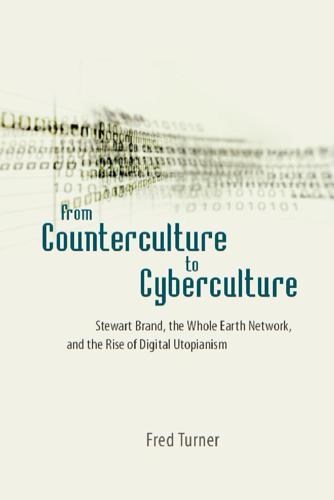
From Counterculture to Cyberculture: Stewart Brand, the Whole Earth Network, and the Rise of Digital Utopianism
by
Fred Turner
Published 31 Aug 2006
The “Magna Carta for the Knowledge Age” represented the combined efforts of four authors: Esther Dyson, George Gilder, Alvin Toffler, and George Keyworth, who was Ronald Reagan’s former science adviser and a current PFF staffer. The document’s preamble opened with a grand flourish: “The central event of the 20th century is the overthrow of matter. . . . The powers of mind are everywhere ascendant over the brute force of things.” On the one hand, this triumph of the immaterial reflected Alvin Toffler’s claim that a “Third Wave” of socioeconomic change was sweeping the world. In the first wave, farming and manual labor dominated the economy; in the second, machines and mass production ruled the land.
…
The builders of computers and telecommunications networks, suggested Wired—men like John Malone of TV cable behemoth TCI, Frank Biondi and Ed Horowitz of Viacom, and Bill Gates of Microsoft—were working to construct the hightech infrastructure of a new and better world. So too were libertarian pundits and politicians. In the logic of Wired, they were simply social, as opposed to technical, engineers. Like their brethren in Silicon Valley, conservative author and media analyst George Gilder, futurist Alvin Toffler, and Republican Speaker of the House Newt Gingrich were working to bring about individual liberation and government by contract and code. Together, Wired seemed to suggest, these two communities had set about to free America and the world from the rigid, oppressive corporate and government bureaucracies of the twentieth century.
…
The elections of 1994 ushered in the first Republican majority in both houses of Congress for forty years. Led by Newt Gingrich, the House of Representatives in the mid-1990s pushed for the downsizing of government and widespread deregulation— especially in the telecommunications sector. Together with Alvin Toffler, George Gilder, and technology journalist and entrepreneur Esther Dyson, Gingrich argued that America was about to enter a new era, one in which technology would do away with the need for bureaucratic oversight of both markets and politics. As Gingrich and others saw it, deregulation would free markets to become the engines of political and social change that they were meant to be.

The Politics of Bitcoin: Software as Right-Wing Extremism
by
David Golumbia
Published 25 Sep 2016
The most important of these redefined terms that occur repeatedly in discussions of Bitcoin are “freedom” and “government,” both of which are central to all cyberlibertarian and political libertarian rhetoric. Referring to the 1994 manifesto “Cyberspace and the American Dream: A Magna Carta for the Knowledge Age” by Esther Dyson, George Gilder, George Keyworth, and Alvin Toffler, Winner (1997, 16) writes: Characteristic of this way of thinking is a tendency to conflate the activities of freedom-seeking individuals with the operations of enormous, profit-seeking business firms. In the “Magna Carta for the Knowledge Age,” concepts of rights, freedoms, access, and ownership justified as appropriate to individuals are marshaled to support the machinations of enormous transnational firms.
…
“The Politics of Cryptography: Bitcoin and the Ordering Machines.” Journal of Peer Production 4 (January). http://peerproduction.net/. DuPont, Quinn, and Bill Maurer. 2015. “Ledgers and Law in the Blockchain.” King’s Review (June 23). http://kingsreview.co.uk/. Dyson, Esther, George Gilder, George Keyworth, and Alvin Toffler. 1994. “Cyberspace and the American Dream: A Magna Carta for the Knowledge Age.” Future Insight (August). http://www.pff.org/. Emery, Joel, and Miranda Stewart. 2015. “All around the World, Regulators Are Realizing Bitcoin Is Money.” The Conversation (August 11). http://theconversation.com/. Epperson, A.
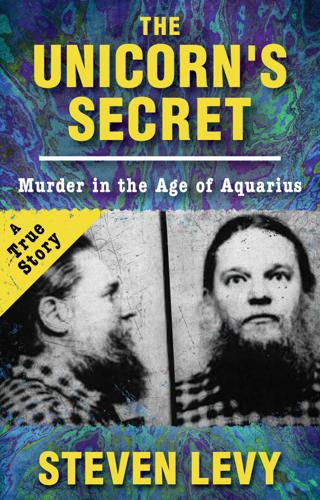
The Unicorn's Secret
by
Steven Levy
Published 6 Oct 2016
“One day we started getting clippings from a man we’d never known, knew nothing about, and they came in envelopes from the telephone company! The clips were wonderful,” says Future Shock author Alvin Toffler. Heidi Toffler, who works closely with her husband, was particularly impressed with information Einhorn circulated on Ilya Prigogine. It was the first the Tofflers heard of the Belgian physicist who was later to win the Nobel Prize. They followed up on it, and Alvin Toffler eventually wrote the preface to Prigogine’s classic, Order Out of Chaos. Einhorn would send out these papers without much comment. Sometimes he would scribble a line or two about the importance of a given document, mentioning perhaps that it dealt with an issue that would attain mind-boggling significance in the months ahead.
…
He met with two close friends, one of them the managing director of the Lehmann Brothers investment firm, the other an executive vice-president of AT&T. Then, in a crosstown hop that could well stand as definitive of his present existence, Ira rode in the phone company executive’s limousine to former radical Jerry Rubin’s apartment, where he would stay the night. The two sixties’ veterans rapped until two. The next day, Ira saw futurist Alvin Toffler, whom Einhorn was instructing on the hands-on aspects of computer conferencing. Then he was off to Washington, DC, to visit with the Congressional Clearinghouse for the Future. Hectic. But hectic was routine for Ira. Einhorn did not have a slow day in March until the twenty-seventh. He slept late, ambled downtown for a lunch with phone company friends, and spent time reading.
…
Word spread throughout New Age circles and the fringe-science community, and people wrote to Ira asking, sometimes begging, to receive goodies from the network. By the mid-1970s Ira Einhorn’s network was a certified phenomenon in and of itself. Names appearing on the cover letters of recipients of a given piece might include economist Hazel Henderson; Lehmann Brothers managing director Shel Gordon; Seagram heir Charles Bronfman; futurist Alvin Toffler; science adviser to the British Commonwealth Christian de Lait; corporate presidents John Haas and George Bartol; Whole Earth Catalog publisher Stewart Brand; physicists Freeman Dyson, David Bohm, Frijtof Capra, and Heinz Pagels; Esalen cofounder Mike Murphy; journalists Alex Cockburn and Jack Anderson; authors Colin Wilson, Robert Theobold, and Thomas Kuhn.
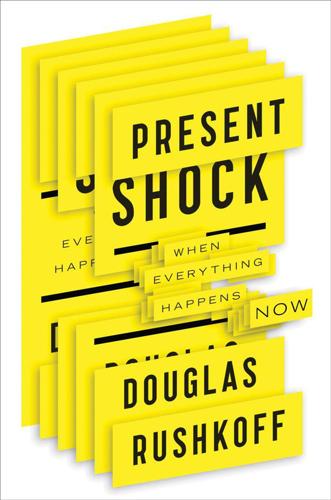
Present Shock: When Everything Happens Now
by
Douglas Rushkoff
Published 21 Mar 2013
Add real-time technologies, from the iPhone to Twitter; a disposable consumer economy where 1-Click ordering is more important than the actual product being purchased; a multitasking brain actually incapable of storage or sustained argument; and an economy based on spending now what one may or may not earn in a lifetime, and you can’t help but become temporally disoriented. It’s akin to the onslaught of changing rules and circumstances that 1970s futurist Alvin Toffler dubbed “future shock.” Only, in our era it’s more of a present shock. And while this phenomenon is clearly “of the moment,” it’s not quite as in the moment as we may have expected. For while many of us were correct about the way all this presentism would affect investments and finance, even technology and media, we were utterly wrong about how living in the “now” would end up impacting us as people.
…
Along with that, however, everything else seemed to be doubling as well—our stock indexes, medical bills, Internet speeds, cable-TV stations, and social networks. We were no longer adjusting to individual changes, we were told, but to the accelerating rate of change itself. We were in what futurist Alvin Toffler called “future shock.” As a result, everything and everyone was leaning toward the future. We weren’t looking forward to anything in particular so much as we were simply looking forward. Trend casters and “cool hunters” became the highest-paid consultants around, promising exclusive peeks at what lie ahead.
…
Back in the quaint midcentury year of 1965, Mary Poppins was awarded five Oscars, the Grateful Dead played their first concert, and I Dream of Jeannie premiered on NBC. But it was also the year of the first spacewalk, the invention of hypertext, and the first successful use of the human respirator. These events and inventions, and others, were promising so much change, so fast, that Alvin Toffler was motivated to write his seminal essay “The Future as a Way of Life,” in which he coined the term “future shock”: We can anticipate volcanic dislocations, twists and reversals, not merely in our social structure, but also in our hierarchy of values and in the way individuals perceive and conceive reality.
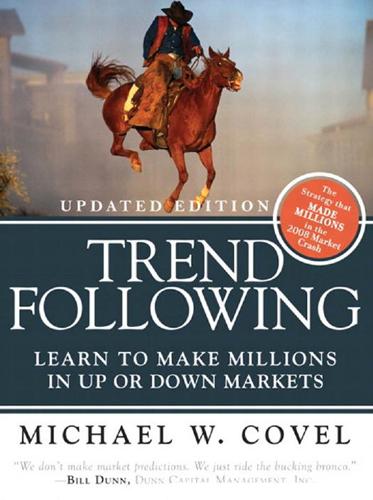
Trend Following: How Great Traders Make Millions in Up or Down Markets
by
Michael W. Covel
Published 19 Mar 2007
Fung and Hsieh’s paper goes a long way to doing for trends what poets have been trying to do for love since time immemorial. They give us a working model that quantitatively defines their value for us. Traders will not be surprised to learn that trend following advisors performed best during extreme market moves, especially during bad months for equities.20 14 Change is not merely necessary to life—it is life. Alvin Toffler Trend Following (Updated Edition): Learn to Make Millions in Up or Down Markets Yet, even when trend following success is brought to their attention, investors are often skeptical. They say the markets have changed and that trend following no longer works. Their concerns usually stem from a random press story of a trend follower who supposedly “blew up” and lost all of his clients’ money.
…
They often panic and pull out just before a big move makes them a lot of money. • Clients may start asking for the trader to change his approach. Although they may not have articulated this directly to the fund manager, they really wanted the trend following strategy 43 Change is not merely necessary to life—it is life. Alvin Toffler 44 Trend Following (Updated Edition): Learn to Make Millions in Up or Down Markets customized for them before investing their money in the first place. The manager is then faced with a difficult decision: Take the client’s money and make money through management fees (which can be lucrative) or trade the capital as originally designed.
…
During her two years of battling unemployment, Levine has worked for $8 an hour at Pottery Barn and for $18 an hour as a temp for a Wall Street trading firm. “I can’t even afford a dog,” she says.33 204 The illiterate of the twenty-first century will not be those who cannot read and write, but those who cannot learn, unlearn, and relearn. Alvin Toffler Human beings never think for themselves, they find it too uncomfortable. For the most part, members of our species simply repeat what they are told—and become upset if they are exposed to any different view. The characteristic human trait is not awareness but conformity…Other animals fight for territory or food; but, uniquely in the animal kingdom, human beings fight for their ‘beliefs’…The reason is that beliefs guide behavior, which has evolutionary importance among human beings.
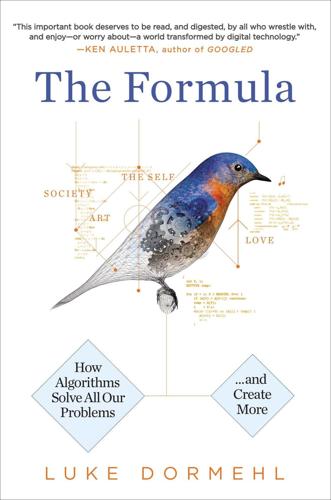
The Formula: How Algorithms Solve All Our Problems-And Create More
by
Luke Dormehl
Published 4 Nov 2014
“It is time for a step-change in advertising,” said Simon Sugar, chief executive of Amscreen, who developed the OptimEyes technology behind the screens. “Brands deserve to know not just an estimation of how many eyeballs are viewing their adverts, but who they are, too.”11 The Wave Theory This notion of appealing to users based on their individual surfing habits taps—ironically enough—into the so-called wave theory of futurist Alvin Toffler.12 In his 1980 book The Third Wave, Toffler described the way in which technology develops in waves, with each successive wave sweeping aside older societies and cultures.13 There have been three such waves to date, Toffler claimed. The first was agricultural in nature, replacing the hunter-gatherer cultures and centering on human labor.
…
In this way it is necessary to ask the degree to which The Formula is genuinely improving working conditions, or whether it is simply (to quote cultural critic Paul Virilio) transforming workers into unwitting participants in a Marxist state pageant, “miming the joys [of] being liberated”—with full knowledge that anything other than full enthusiasm will be noted down against their CourseSmart-style engagement index and unearthed by an algorithm in time for a future job interview. Here it is worth turning once more to the work of Alvin Toffler, whose concept of “demassification” laid out many of the principles described in this chapter. In The Third Wave, Toffler questions why it is that everyone should be asked to start work at 9 A.M. and finish at 5 P.M. each day. By changing this massified approach to a more individual one, centered around the self, Toffler argues that both employers and employees would experience benefits.
…
We’ll just get different prices, different news, different entertainment.”42 The Discrimination Formula? A number of Internet theorists have argued that in the digital world, previous classifications used for discrimination (including race, gender or sexuality) will fall away—if they haven’t already. Alvin Toffler’s Third Wave identifies a number of individuals and groups subtly or openly discriminated against during the last centuries and argues that this marginalization is the product of Second Wave societies. According to Toffler, in the unbundled, personality-driven Third Wave society such discriminatory practices will slink off into the digital ether.

Ayn Rand and the World She Made
by
Anne C. Heller
Published 27 Oct 2009
It was the first time the nation had been without a draft since FDR reinstated one in 1940, in preparation for America’s entry into World War II. Rand never wrote about her indirect role in this achievement, but she did endorse Nixon in 1968, partly on the basis of his opposition to the draft. Perhaps the purest, least rhetorical, and hardest-hitting public statement of her views appeared in a March 1964 Playboy interview. With Alvin Toffler, who in 1970 would publish Future Shock, asking the questions, the text crackled with maverick intelligence. Explaining her choice of the dollar sign as an emblem in Atlas Shrugged and a trademark decoration on her person, she said, “As the symbol of the currency of a free country, [it] is the symbol of a free mind.”
…
Rockwell, Jr., Ludwig von Mises Institute; Bernice Glatzer Rosenthal; Allan Ryskind; Roger Salamon; Roberta Satro; Wilfred Schwartz; Marc Schwalb; Chris Matthew Sciabarra; Duncan Scott, director, the Objectivist History Project; Marian L. Smith, historian, History Office and Library, U.S. Citizenship and Immigration Services, Department of Homeland Security; Betsy Speicher; Ellen Stuttle; Joan Kennedy Taylor (deceased); William Thomas, director of programs at the Atlas Society; John Thornton; Henry Teitel; Alvin Toffler; James S. Valliant; Don Ventura; Jeffrey Walker; Mike Wallace; Greg Walsh, archivist, the Margaret Herrick Library of the Academy of Motion Picture Arts and Sciences; Eugene Winick; Marna Wolf. Special thanks to Barbara Branden, who gave generously of her time, knowledge, and resources; to Nathaniel Branden, who spoke with me at length, on multiple occasions; and to Patricia O’Toole, without whose encouragement this book would not have been written.
…
A few years later she would tell a friend: Author interview with Nathaniel Branden, December 11, 2008. Marna, had quit high school: Letter to Mimi Sutton, April 30, 1946 (LOAR, p. 275). She and Frank agreed to pay: Letter to Mimi Sutton, March 24, 1946 (LOAR, pp. 265–66). a strain developed: Author interview with MW, June 21, 2004. she did not see it as a moral duty: Alvin Toffler, “The Playboy Interview: Ayn Rand,” Playboy, March 1964, p. 40. the old and the lame, she complained: Letter to Marjorie Williams, June 18, 1936 (LOAR, p. 32). “I considered it an investment”: Author interview with MW, June 21, 2004. Similarly, when discussing Thaddeus Ashby’s long residence: BBTBI.

Paper Knowledge: Toward a Media History of Documents
by
Lisa Gitelman
Published 26 Mar 2014
To some extent that is certainly the case, though saying so too easily neglects the massive diversity of digital communications, which include everything from blogs and vlogs with the tenor of zines to backward- looking, paper-imagining forms like the pdf , now used to e-publish so that others may print out. In addition, diy publishing needs to be located within and against diy more generally. The futurologist Alvin Toffler, who was already using the term “prosumer” in 1980—alas not “prosumerdom”—came pretty close to predicting today’s independent video, home offices, and distributed computing, but his description of 1980s-style diy may come as more of a surprise. His futurological extrapolations take as their point of departure the then-new diy home pregnancy test kits; direct long-distance telephone dialing; self-service gasoline pumps; and automated teller machines (atm s).56 Add the then-familiar mix tapes, copy shops, and film-processing kiosks, and I think it makes a wonderfully evocative context for—among other things—the imminent availability of desktop publishing, which arrived courtesy of Aldus and Apple to the embrace of amateurs and others. 150 AFTERWORD N OT E S P R E FAC E 1.
…
Shoshana Zuboff, In the Age of the Smart Machine: The Nature of Work and Power (New York: Basic, 1984), 125. 53. Ames, Beyond Paper, 45–47, 85. 54. Ibid., 93. 55. Streeter, The Net Effect, 124 (emphasis in the original). A related point about the uneven penetration of technological change had been made before by Alvin Toffler in The Third Wave (New York: William Morrow, 1980), 207–8. 56. Jacques Derrida, Paper Machine, trans. Rachel Bowlby (Stanford, CA: Stanford University Press, 2005), 29. 57. These generalizations by me and others are supported and elaborated by ethnographic accounts, including Harper, Inside the imf; Zuboff, In the Age of the Smart Machine; and Sellen and Harper, The Myth of the Paperless Office.
…
Lee Harrington (New York: New York University Press, 2007), 7, 16; this last is Henry Jenkins’s point, elaborated in his conclusion to this volume, “Afterword: The Future of Fandom,” 357–64. 53. Michael Warner, Publics and Counterpublics (New York: Zone, 2002). 54. I elaborate this point in Always Already New: Media, History, and the Data of Culture (Cambridge, MA: mit Press, 2006), chapter 4. 55. Susan Sontag, On Photography (New York: Farrar, Straus, and Giroux, 1977), 21. 56. Alvin Toffler, The Third Wave (New York: William Morrow, 1980), 286, 368– 69. N OT E S TO A F T E R W O R D 187 WORKS CITED Acland, Charles R. “Introduction: Residual Media.” In Residual Media, edited by Charles R. Acland, xiii–xxvii. Minneapolis: University of Minnesota Press, 2007. Adelman, Joseph M.
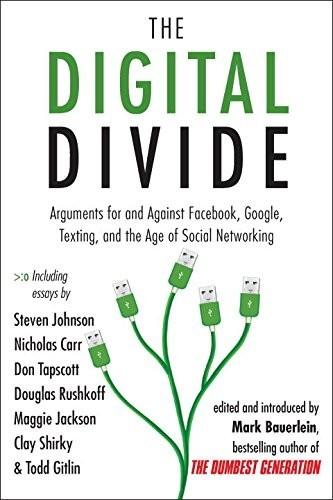
The Digital Divide: Arguments for and Against Facebook, Google, Texting, and the Age of Social Netwo Rking
by
Mark Bauerlein
Published 7 Sep 2011
This number rises to 61 percent of Early Adopters and 74 percent of the Bleeding Edge. However, they hesitate to share the data if they feel a company might misuse the information, sell it to other companies, or inundate them with junk mail and spam.24 Now, Net Gen consumers are taking the next step and becoming producers, cocreating products and services with companies. Alvin Toffler coined the term “prosumer” in his 1970s book Future Shock.25 I called it “prosumption” a decade ago.26 I can see it happening now, as the Internet transforms itself from a platform for presenting information to a place where you can collaborate and where individuals can organize themselves into new communities.
…
Patent No. 6820062 (issued November 16, 2004). 16 Don Tapscott and David Ticoll, The Naked Corporation: How the Age of Transparency Will Revolutionize Business (Free Press, 2003). 17 “The Net Generation: A Strategic Investigation,” Syndicated Research Project, nGenera, 2008 (survey of 1,750 respondents aged thirteen to twenty-nine, September–October, 2006). 18 Ibid. 19 Ibid. 20 David Richards, “Free Illegal Music Beats iTunes,” SmartHouse, November 30, 2005, www.smarthouse.com.au. 21 “The Net Generation: A Strategic Investigation,” Syndicated Research Project, nGenera, 2008 (survey of 1,750 respondents aged thirteen to twenty-nine, September–October 2006). 22 Mary Madden and Amanda Lennart, “Pew Internet Project Data Memo,” Pew Internet and American Life Project, July 31, 2003. 23 Frank Rose, “And Now, a Word from Our Customers,” Wired 14, no. 12, December 2006. 24 “The Net Generation: A Strategic Investigation,” Syndicated Research Project, nGenera, 2008 (survey of 1,750 respondents aged thirteen to twenty-nine, September–October 2006). 25 Alvin Toffler, Future Shock (Bantam Books, 1971). 26 Don Tapscott, The Digital Economy: Promise and Peril in the Age of Networked Intelligence (McGraw-Hill, 1995). 27 “The Net Generation: A Strategic Investigation,” Syndicated Research Project, nGenera, 2008 (survey of 1,750 respondents aged thirteen to twenty-nine, September–October 2006). 28 Ibid. 29 Steve Hamm and Ian Rowley, “Speed Demons,” BusinessWeek, March 27, 2006. 30 Jena McGregor, “The World’s Most Innovative Companies,” BusinessWeek , April 24, 2006
…
We’re closer to a vision of “producer democracy” than we are to any of the consumerist views that long ago took hold in the mass media, including much of the journalism presented on that platform. We won’t know what a producer public looks like from looking at the patterns of the media age, in which broadcasting and its oneto-many economy prevailed. But we do know what a “producer public” will look like. Alvin Toffler described it thirty years ago. It will look like a totalized “consumerist” society, where everyone’s spare moment is on the market and where journalists in the blogosphere will have their every word quantified and evaluated by vigilant advertisers. Where “producers” are simply consumers made more dependent on the marketplace by the illusion of greater participation in the marketplace.

The Sirens' Call: How Attention Became the World's Most Endangered Resource
by
Chris Hayes
Published 28 Jan 2025
Mass culture has given way to fractally reproduced subcultures, a discourse dominated by what’s trending and what’s viral, a collective attention that is pushed and pulled and worked over in each little sliver of our waking lives, aggregated into a whole that feels like it is far less than the sum of its parts. Chapter 6 Dawn of the Attention Age In 1980, bestselling futurist Alvin Toffler divided human history into three epochs in his book The Third Wave.[1] The first wave was the Neolithic revolution, which most anthropologists agree began around twelve thousand years ago. That was when hunter-gatherers transitioned to agricultural societies that settled in one place and grew their own food.
…
Census Bureau History: Philo Farnsworth and the Invention of Television,” US Census Bureau, accessed January 28, 2024, www.census.gov/history/www/homepage_archive/2023/september_2023.html. BACK TO NOTE REFERENCE 47 Arthur C. Clarke, Profiles of the Future: An Inquiry into the Limits of the Possible (New York: Harper & Row, 1973), 38. BACK TO NOTE REFERENCE 48 Chapter 6: Dawn of the Attention Age Alvin Toffler, The Third Wave (New York: Random House, 1980). BACK TO NOTE REFERENCE 1 Toffler, The Third Wave, 12. BACK TO NOTE REFERENCE 2 It was in 1960 that the phrase “the information age” first made its appearance, in a small technical publication by a man who would both found a surveillance company and head up intelligence and reconnaissance systems development at the Pentagon.
…
Stecina, Rebecca Cseh, and Michael C. Hout, “The Effects of Task-Irrelevant Threatening Stimuli on Orienting- and Executive Attentional Processes Under Cognitive Load,” British Journal of Psychology 113, no. 2 (2022): 412–33, https://doi.org/10.1111/bjop.12540. BACK TO NOTE REFERENCE 9 Alvin Toffler, Future Shock (New York: Random House, 1970), 371. BACK TO NOTE REFERENCE 10 Toffler, Future Shock, 366. BACK TO NOTE REFERENCE 11 Herbert A. Simon, “Designing Organizations for an Information-Rich World,” in Computers, Communications, and the Public Interest, ed.

The Human City: Urbanism for the Rest of Us
by
Joel Kotkin
Published 11 Apr 2016
In contrast to the walled-in city of the imperial era, the producer city’s walls were moved back, and new populations were absorbed into suburbs, much like in the modern city.28 THE RISE OF THE INDUSTRIAL CITY The modern city emerged from the producer city but in ways fundamentally transformed by the Industrial Revolution. Futurist and author Alvin Toffler points out that this “second wave,” or industrial, society accelerated urban density and concentration, in part due to the need to keep the workforces of new factories and associated businesses in close proximity. It did so by “stripping the countryside of people and relocating them in giant urban centers.”29 This was most notable in Britain in the centuries leading up to the Industrial Revolution.
…
For my generation, it will be harder.”125 BEYOND THE CASH NEXUS We are entering an era for which there is no real precedent. Today’s market system has created wonders and spread prosperity around much of the world, but it has not been too kind to the family. The ideal corporate executives of today, futurist Alvin Toffler noted over three decades ago, are those who have “dissolved” themselves from “their deep emotional attachments with their families of birth.” But this represents just the beginning. To Toffler, the nuclear family represents “the second wave” of human existence, which is being replaced by a more flexible “third wave” lifestyle.126 “Just as the nuclear family was promoted by the rise of the factory and office work,” Toffler suggests, “any shift away from the factory or the office would also exert a heavy influence on the family.”127 Family ties have also been undermined by the fierce competition of this highly globalized “third wave” economy.
…
In his book, Pilot cites a 2012 survey of 3,000 millennial-generation business owners, which found that 82 percent believe many businesses will be built entirely with virtual teams of online workers by 2022.156 Millennials, in particular, may be attracted to the environmental savings that can result from reduced office energy consumption, roadway repairs, urban heating, office construction, business travel, and paper usage (as electronic documents replace paper).157 Overall, according to a 2007 survey, greater use of telecommuting in the United States alone could save 1 billion tons of emissions over 10 years.158 Yet for most, the real benefit of telework is smashing the great barrier between work and home life. We may well be on the verge of the home-centered urban paradigm first envisioned by futurist Alvin Toffler more than four decades ago. In his vision, the house becomes “the electronic cottage,” the center of a new economy, with benefits not only for the environment but also for families, partly from allowing mothers and fathers to work while being active parents.159 The implication for housing forms is fairly obvious: as people use houses for work, they are likely to look for larger—not smaller—and more comfortable places to live.
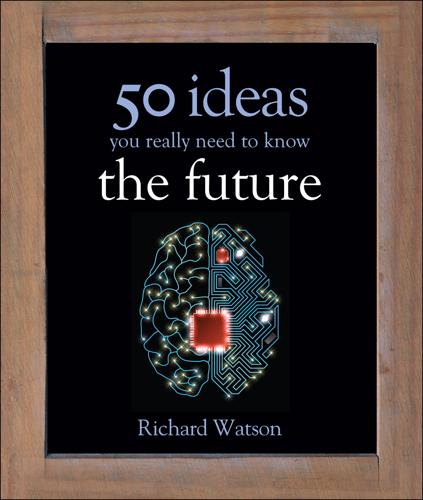
50 Future Ideas You Really Need to Know
by
Richard Watson
Published 5 Nov 2013
It also means that voting in supermarkets, in McDonald’s and on the bus will all be possible and perhaps even encouraged in the future. “The political technology of the industrial age is no longer appropriate technology for the new civilization taking form around us. Our politics are obsolete.” Alvin Toffler, author of Future Shock The up side The hope is that developments such as these will make politics more interesting and politicians more accountable and honest. Gone will be the days of utterances made in small rooms “off the record” in the full knowledge that such remarks will not be captured by a television news crew.
…
We’re still reeling from 9/11, the global financial crisis, climate change and political upheaval. It feels as though change has itself changed and we’re all struggling to keep up. But will this last? Perhaps the issue is that we’re currently exposing ourselves to too much information and this is resulting in temporary disorientation. In the early 1970s, Alvin Toffler wrote a best-selling book called Future Shock. The author argued that too much technological change, or at least the perception of too much rapid change, over what was felt to be too short a period of time, was resulting in psychological damage to individuals and even to society as a whole. Toffler also placed the term “information overload” into the general consciousness.
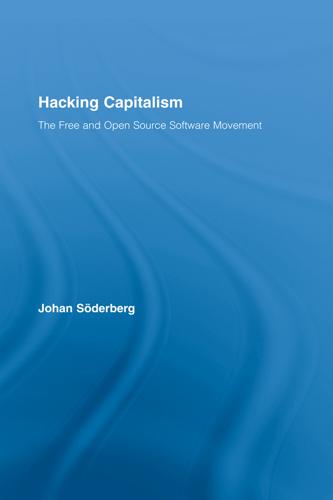
Hacking Capitalism
by
Söderberg, Johan; Söderberg, Johan;
The social causes for conflicts in capitalism would give way together with the manufacturing industry. One of the earliest and most scholarly inclined among post-industrial thinkers is Daniel Bell.2 Writing in the 1960s and 1970s, Daniel Bell paved the way for more popularised works by futurists like Alvin Toffler, Peter Drucker and Robert Reich, just to mention the most influential names. With the advent of the Internet in the 1990s, similar thoughts surfaced yet again taking a slightly different shape, this time emphasising networks and information. A milestone is the three-volume study of the so called ‘network society’ by the sociologist Manuel Castells.
…
Instead these critics like to highlight the example set by FOSS ventures and underground record labels that experiment with alternative licenses. In such forward-thinking business models, customers and users are invited to participate in the development process. Their argument resonates with a claim first made by the futurist Alvin Toffler in the early 1980s. He too predicted a merger between the producer and the consumer and invented the neologism ‘the prosumer’ for his new creature.14 Both Toffler and contemporary critics of intellectual property law give credit to digital technology as the agent behind this transformation. Typically, the interactivity of videogames is contrasted with the passivity of watching television, and a vague optimism is attached to the surge of new media.
…
Douglas Kellner, Jean Baudrillard—From Marxism to Postmodernism and Beyond (Cambridge: Polity Press, 1989), and, Martyn Lee, Consumer Culture Reborn—The Cultural Politics of Consumption (London: Routledge 1993). 13. Naomi Wolf, The Beauty Myth—How Images of Beauty Are Used Against Women (London: Vintage, 1991), 76. She goes on to remind the reader that the opposite concept of beauty is when the features of a person become attractive to another person because of their unique relation. 14. Alvin Toffler, The Third Wave (New York: Bantam Books, 1981). 15. Paul du Gay, Consumption and Identity at Work, (London: Sage, 1995). 16. Stephen Kline, Nick Dyer-Witheford & Greig De Peuter, Digital Play—The Interaction of Technology, Culture, and Marketing, London: McGill-Queen’s University Press, 2003. 17.

The Coming Wave: Technology, Power, and the Twenty-First Century's Greatest Dilemma
by
Mustafa Suleyman
Published 4 Sep 2023
GO TO NOTE REFERENCE IN TEXT The ten thousand years Lipsey, Carlaw, and Bekar, Economic Transformations. GO TO NOTE REFERENCE IN TEXT And in the last hundred The remainder coming between 1000 BCE and 1700 CE. GO TO NOTE REFERENCE IN TEXT For the futurist Alvin Toffler Alvin Toffler, The Third Wave (New York: Bantam, 1984). See also the work of Nikolai Kondratiev on long-cycle waves. GO TO NOTE REFERENCE IN TEXT The great philosopher of technology Lewis Mumford, Technics and Civilization (Chicago: University of Chicago Press, 1934). GO TO NOTE REFERENCE IN TEXT More recently the economist Carlota Perez, Technological Revolutions and Financial Capital: The Dynamics of Bubbles and Golden Ages (Cheltenham, U.K.: Edward Elgar, 2002).
…
Waves—pulsating, emergent, successive, compounding, and cross-pollinating—define an era’s horizon of technological possibility. They are part of us. There is no such thing as a non-technological human being. This conception of history as a series of waves of innovation is not novel. Sequential and disruptive clusters of technologies recur in discussions of technology. For the futurist Alvin Toffler, the information technology revolution was a “third wave” in human society following the Agricultural and Industrial revolutions. Joseph Schumpeter saw waves as explosions of innovation igniting new businesses in bursts of “creative destruction.” The great philosopher of technology Lewis Mumford believed the “machine age” was actually more like a thousand-year unfolding of three major successive waves.
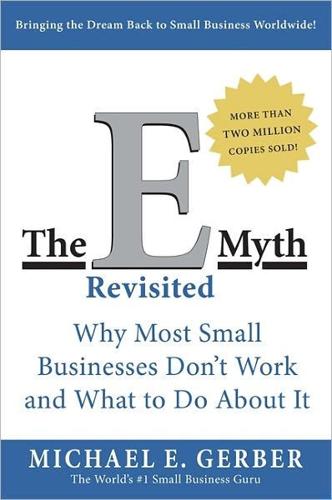
The E-Myth Revisited: Why Most Small Businesses Don't Work and What to Do About It
by
Michael E. Gerber
Published 3 Mar 1995
“Although I sense that you already understand quite a bit more than you think. But first, let’s go on to Adolescence, the second stage in a small business’s growth.” ADOLESCENCE: GETTING SOME HELP As governments, we stumble from crisis to crash program, lurching into the future without plan, without hope, without vision. Alvin Toffler The Third Wave Adolescence begins at the point in the life of your business when you decide to get some help. There’s no telling how soon this will happen. But it always happens, precipitated by a crisis in the Infancy stage. Every business that lasts must grow into the Adolescent phase.
…
And it doesn’t take a genius to see that the world today is in a state of massive chaos. Wars, famine, crime, violence, inflation, recession, a shifting of traditional forms of social interaction, the threat of nuclear proliferation, HIV, holocaust in all its horrific forms are all communicated instantly and continuously to the fixated consumer, to all of us watching TV. As Alvin Toffler wrote in his revolutionary book, The Third Wave, “…most people surveying the world around them today see only chaos. They suffer a sense of personal powerlessness and pointlessness.” He went on to say that, “Individuals need life structure. A life lacking in comprehensive structure is an aimless wreck.

The City: A Global History
by
Joel Kotkin
Published 1 Jan 2005
.: MIT Press, 1995), 94–98; Doug Bartholomew, “Your Place or Mine?,” CFO magazine, March 15, 2004; Sheridan Tatsuno, The Technopolis Strategy: Japan, High Technology and the Control of the 21st Century (New York: Prentice Hall, 1986), xv–xvi; Bruce Stokes, “Square One,” National Journal, May 24, 1997; Alvin Toffler, The Third Wave (New York: William Morrow, 1980), 204–7. 24. Fishman, op. cit., 187; U.S. Census analysis by William Frey, Brookings Institution; Technological Reshaping of America, 93; Sara B. Miller, “Big Cities Struggle to Hold On to New Immigrants as Costs Rise,” Christian Science Monitor, October 9, 2003; “U.S.
…
Of somewhat more recent vintage but also quite prophetic are Manuel Castells’s The Information Age: Economy, Society and Culture, Volume III: End of Millennium (Blackwell Publishers, 1998); Jacques Ellul’s The Technological Society, translated by John Wilkinson (Vintage, 1967); Taichi Sakaiya’s The Knowledge-Value Revolution, or, A History of the Future, translated by George Fields and William Marsh (Kodansha, 1985); Daniel Bell’s The Coming of Post-Industrial Society: A Venture in Social Forecasting (Basic Books, 1973); and works by Alvin and Heidi Toffler, and most particularly Alvin Toffler’s The Third Wave (William Morrow, 1980). THE MODERN LIBRARY EDITORIAL BOARD Maya Angelou A. S. Byatt Caleb Carr Christopher Cerf Charles Frazier Vartan Gregorian Richard Howard Charles Johnson Jon Krakauer Edmund Morris Azar Nafisi Joyce Carol Oates Elaine Pagels John Richardson Salman Rushdie Oliver Sacks Arthur M.

The Economic Singularity: Artificial Intelligence and the Death of Capitalism
by
Calum Chace
Published 17 Jul 2016
In his 1962 book, The production and distribution of knowledge in the United States, he introduced the notion of the knowledge industry, by which he meant education, research and development, mass media, information technologies, and information services. He calculated that in 1959, it accounted for almost a third of US GDP, which he felt qualified the US as an information society. Alvin Toffler, author of the visionary books Future Shock (1970) and The Third Wave (1980), argued that the post-industrial society has arrived when the majority of workers are doing brain work rather than personally manipulating physical resources – in other words when they are part of the service sector. Services grew to 50% of US GDP shortly before 1940,[viii] and they first employed the majority of working Americans around 1950.
…
Demand forecasting, product mix planning, purchasing, storage, goods handling, distribution, shelf stacking, customer service and many other aspects of the business have been automated to varying extents in different places and at different times. The retail industry has also given us the clearest examples of another, associated phenomenon known as “prosumption”. This term was coined in 1980 by the American futurist Alvin Toffler, one of the leading thinkers about the trends we are discussing in this book. At the same time as organisations automate many of their processes, they enlist the help of their customers to streamline their operations. In fact, they get their customers to do some of the work that was previously done for them.
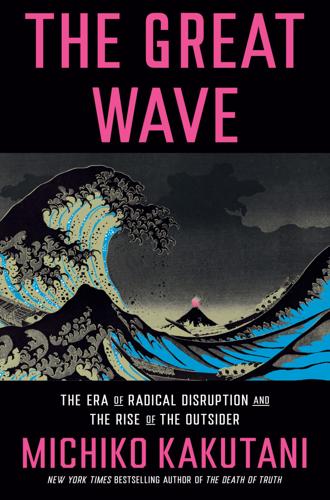
The Great Wave: The Era of Radical Disruption and the Rise of the Outsider
by
Michiko Kakutani
Published 20 Feb 2024
And this at a time when mistrust in the government and traditional sources of authority have been building since the economic meltdown of 2008, which fueled populist anger at institutions and elites. These developments have created a vertiginous moment that has exposed our interdependent world’s profound vulnerabilities. Growing cracks appear in the post–World War II order and the ever-accelerating pace of social and technological change have created what Alvin Toffler described, five decades ago, as “future shock” and “adaptive breakdown.” But times of turmoil can also provide an opening for a reboot—for reassessing our priorities and operating principles. New ideas are more likely to gain traction during such periods, and newcomers are increasingly welcomed in once cloistered fields.
…
GO TO NOTE REFERENCE IN TEXT “technology is neither good nor bad”: Eric Schatzberg and Lee Vinsel, “Kranzberg’s First and Second Laws,” Technology’s Stories 6, no. 4 (Dec. 2018), technologystories.org/first-and-second-laws/; Rinkesh D, “Kranzberg’s Laws of Technology—Understanding Interaction of Society and Technology,” AIC-IIITH, aic.iiit.ac.in/kranzbergs-laws-of-technology-understanding-interaction-of-society-and-technology/. GO TO NOTE REFERENCE IN TEXT “future shock” and “adaptive breakdown”: Alvin Toffler, Future Shock (New York: Bantam Books, 1971). GO TO NOTE REFERENCE IN TEXT Times of tumult and chaos: George Prochnik, Stranger in a Strange Land (New York: Other Press, 2016), 247–48. GO TO NOTE REFERENCE IN TEXT fossil fuel consumption: ipcc.ch/report/ar6/syr/downloads/report/IPCC_AR6_SYR_LongerReport.pdf.
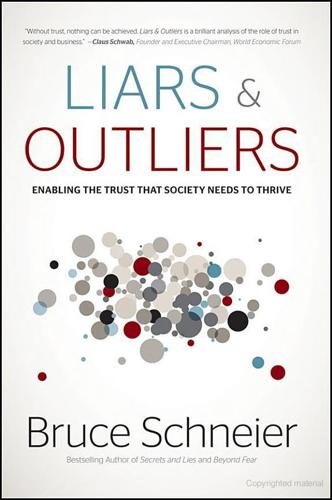
Liars and Outliers: How Security Holds Society Together
by
Bruce Schneier
Published 14 Feb 2012
Criminals were simply Warwick Ashford (6 Oct 2010), “ISSE 2010: Police Are Playing Catch-Up as Criminals Embrace IT,” Computer Weekly. Stephen Pritchard (2 Jun 2011), “Vulnerabilities: Battle Is Joined on Two Fronts,” Financial Times. position of the interior Carl von Clausewitz (1832), On War. Alvin Toffler wrote Alvin Toffler (1970), Future Shock, Random House. People learn how Michael Anissimov (2004), “Future Shock Level Analysis,” AcceleratingFuture.com. new type of grifter David Maurer (1940), The Big Con: The Story of the Confidence Man, Bobbs Merrill. Other cities followed J.L. Lyman (1964), “The Metropolitan Police Act of 1829: An Analysis of Certain Events Influencing the Passage and Character of the Metropolitan Police Act in England,” The Journal of Criminal Law, Criminology, & Police Science, 55:141–54.
…
This is an intrinsic condition of the problem, for all the reasons we just talked about. The security gap cannot be eliminated. The security gap is also greater in periods of rapid technological change, as society struggles to manage the broader social changes as well as quickly adapting defectors do. In 1970, futurist Alvin Toffler wrote about future shock, the psychological and social problems that result from people being forced to absorb too much technological change too quickly. His estimates about how much technological change people could deal with were way too low—the rate of technological change in the second decade of the 21st century is much faster than the seventh decade of the 20th—but his basic ideas are sound.
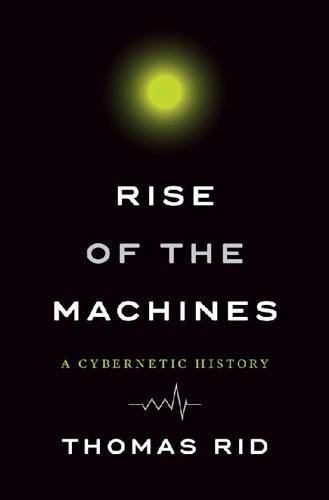
Rise of the Machines: A Cybernetic History
by
Thomas Rid
Published 27 Jun 2016
One book in particular influenced the threat perception: Clifford Stoll’s 1989 The Cuckoo’s Egg chronicled how a German hacker breached Lawrence Berkeley National Laboratory and then sold stolen files to the KGB, Russia’s spy agency.39 In 1991 the Michelangelo virus caused a major scare. Then, in February 1993, an Islamic extremist detonated a huge truck bomb underneath the North Tower of the World Trade Center in Manhattan. The tower didn’t collapse, but the incident highlighted how vulnerable America’s infrastructure was. Futurists Heidi and Alvin Toffler, in a widely read 1993 book, War and Anti-war, again repeated Schwartau’s warning.40 A single Islamic extremist with a computer and a modem, they argued, could cause immense damage to entire armies 10,000 miles away. Hackers weren’t just pranksters, and technology empowered the weak. The Pentagon became concerned—and decided to put these theories to a test.
…
In the Rand-simulated crisis, cyberwar was truly coming: hackers caused a catastrophic flow malfunction at the largest refinery in Saudi Arabia; crashed a high-speed train in Maryland, killing sixty; took CNN off-line; downed an airliner into a residential area in Chicago; grounded all types of a specific Airbus model; sabotaged the London and New York stock exchanges; messed with US command-and-control systems on ships and aircraft; triggered a revolution in Saudi Arabia; and brought about a host of other calamities. Computers, the Rand analysts were sure, would become veritable weapons.43 But computers weren’t like other military weapon systems. Everybody could buy one, and everybody could write code, so everybody could attack—not just states. “It’s the great equalizer,” Alvin Toffler told Time magazine after the exercise. “You don’t have to be big and rich to apply the kind of judo you need in information warfare.”44 National-security officials in Washington understood that hackers were not alone. America’s adversaries would take advantage of this new attack vector. “We’re more vulnerable than any nation on earth,” added then NSA director Vice Admiral John McConnell.45 Soon, elected politicians became concerned as well.
…
House of Representatives, One Hundred Second Congress, First Session, June 27, 1991, no. 42 (Washington, DC: Government Printing Office, 1991), 10. 37.Winn Schwartau, Terminal Compromise (Old Hickory, TN: Interpact Press, 1991). 38.Steven Levy, Hackers (New York: Doubleday, 1984). 39.Clifford Stoll, The Cuckoo’s Egg (New York: Doubleday, 1989). 40.Alvin Toffler and Heidi Toffler, War and Anti-war: Survival at the Dawn of the 21st Century (Boston: Little, Brown, 1993). 41.Bob Brewin and Elizabeth Sikorovsky, “Information Warfare: DISA Stings Uncover Computer Security Flaws,” Federal Computer Week 9, no. 3 (1995): 1, 45. 42.Neil Munro, “The Pentagon’s New Nightmare: An Electronic Pearl Harbor,” Washington Post, July 16, 1995, C03. 43.Roger C.

Make Your Own Job: How the Entrepreneurial Work Ethic Exhausted America
by
Erik Baker
Published 13 Jan 2025
Maslow’s friend Warren Bennis, the successor of Douglas McGregor at MIT’s management school, wrote in 1968 that the new high-tech firms were distinguished by their reliance on “adaptive, problem-solving, temporary systems of diverse specialists, linked together by coordinating and task-evaluating executive specialists in an organic flux,” as opposed to the clearly defined hierarchies and rigid organizational charts that allegedly plagued old-school corporate management. In his 1970 bestseller Future Shock, the journalist Alvin Toffler, citing Bennis, christened this system of temporary, task-oriented assemblages of specialists “ad-hocracy.” “There is excitement and creativity in the computer industry” and other high-tech industries, Toffler wrote. “The new spirit in these transient organizations is closer to that of the entrepreneur than the organization man.”
…
The “trick” to making simulated entrepreneurship work, Peters and Waterman wrote, was “socializing the managers to believe they are would-be champions, yet at the same time maintaining very substantial control where it counts.”15 Sometimes striking the right balance meant adopting techniques that encouraged entrepreneurial behavior without ceding the full scope of discretion implied by the Pinchot system and its predecessors. One option was to rely as much as possible on temporary task forces for traditional project-management operations, along the lines of Alvin Toffler’s “ad-hocracy,” while dispensing with the whole intra-capital apparatus. The percentage of large firms using some self-managed teams increased from 28 percent at the start of the 1980s to 68 percent by 1993. Norman Macrae saw the adhocratic model as the ideal structure for the intrapreneurial organization, although he urged that teams be kept “very small, probably not more than 10 or 11 people.”
…
(Washington, DC: Center for Study of Responsive Law, 1982), v; Sabin, Public Citizens, 165. 21Sabin, Public Citizens, 88–89. 22Hughes, Good Works, xv, xxvii, xxv, viii. 23Drucker, Innovation and Entrepreneurship, 10–11. 24Mahlon Apgar and McKinsey and Company, New Perspectives on Community Development (New York: McGraw-Hill, 1976), 137. 25Drucker, Age of Discontinuity, 294. 26Drucker, Innovation and Entrepreneurship, 171. 27Drucker, Innovation and Entrepreneurship, 16, 82. 28Drucker, Age of Discontinuity, 42–43; Gabriel Winant, The Next Shift: The Fall of Industry and the Rise of Health Care in Rust Belt America (Cambridge, MA: Harvard University Press, 2021), ch. 5. 29Warren Bennis, “Beyond Bureaucracy,” in The Temporary Society, ed. Bennis and Philip Slater (San Francisco, CA: Jossey-Bass, 1998 [1968]), 83; Alvin Toffler, Future Shock (New York: Bantam Books, 1970), 148. Later editions of Future Shock would acknowledge Toffler’s wife, Heidi Toffler, as coauthor. 30Tom Wolfe, “The Tinkerings of Robert Noyce: How the Sun Rose on the Silicon Valley,” Esquire, December 1983, 346–377. See also Leslie Berlin, The Man Behind the Microchip: Robert Noyce and the Invention of Silicon Valley (New York: Oxford University Press, 2005); Michael Malone, The Intel Trinity: How Robert Noyce, Gordon Moore, and Andy Grove Built the World’s Most Important Company (New York: Harper Business, 2004). 31Steve Jobs, informal interview by Bob Brown, February 18, 1981, Apple headquarters, Cupertino, CA, ABC News archives, first made public on YouTube account Sir Mix-A-Lot Rare Music.
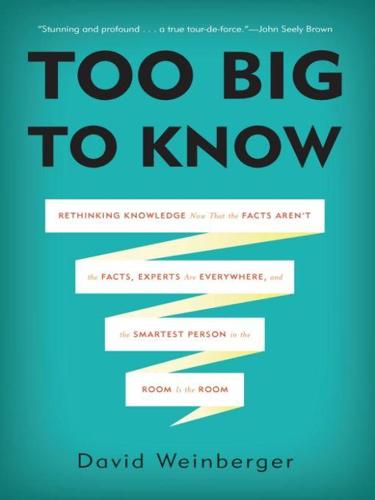
Too Big to Know: Rethinking Knowledge Now That the Facts Aren't the Facts, Experts Are Everywhere, and the Smartest Person in the Room Is the Room
by
David Weinberger
Published 14 Jul 2011
Rather than knowing-by-reducing to what fits in a library or a scientific journal, we are now knowing-by-including every draft of every idea in vast, loosely connected webs. And that means knowledge is not the same as it was. Not for science, not for business, not for education, not for government, not for any of us. Info Overload as a Way of Life Information overload isn’t what it used to be. Alvin Toffler introduced the idea of information overload to the general public in 1970 in his book Future Shock.12 He positioned information overload as a follow-on to sensory overload:13 When our environment throws too many sensations at us—say, at a Grateful Dead concert with a light show and the mixed scents of a thousand sticks of incense—our brains can get confused, causing a “blurring of the line between illusion and reality.”14 But what happens when we go up a level from mere sensation, and our poor little brains are buffeted by information?
…
Smitha, “An Imperfect Democracy,” in Macrohistory and World Report, http://www.fsmitha.com/h1/hell04.htm. 11 The IBM 650 could use the “IBM 650 Magnetic Drum Data Processing machine with a series of disk memory units, which are capable of storing a total of 24-million digits” (http://www-03.ibm.com/ibm/history/exhibits/650/650_pr2.html). I am assuming that a desktop computer these days has a terabyte of hard-disk space. 12 Alvin Toffler, Future Shock (Random House, 1970), p. 350. The term “information overload” appeared as early as 1962; see Bertram M. Gross, “Operation Basic: The Retrieval of Wasted Knowledge,” Journal of Communication 12 (1967): 67–83, DOI: 10.1111. And Norbert Wiener talked about overloading the nervous system even earlier in his 1948 book Cybernetics (MIT Press, reprinted in 1961). 13 The concept of sensory overload was itself new.

Social Life of Information
by
John Seely Brown
and
Paul Duguid
Published 2 Feb 2000
And, to return to the question we raised in the last chapter, is the current approach to technology design leading in the right direction, or may it again be focusing too tightly on an idealized view of information and how itand individualswork? Just a Click Away? The home office may seem little more than a click away, but predictions have put it just over the horizon for some time now. In 1980, Alvin Toffler predicted that within our lifetime urban downtowns would "stand empty, reduced to use as ghostly warehouses or converted into living space. "Yet a 1998 survey shows that the office vacancy rate dropped to single digits for the first time since 1981, despite office completions doubling in 1997. 4 Another prediction claimed 66 percent of workers would work from home by the millennium.5 Though reliable figures are hard to find, it would take a startling burst between now and 2000 to reach even 6 percent.
…
Gates, 1995, p. 21; Gordon Bell and James N. Gray, quoted in Nardi and O'Day, 1999; Phillips, quoted in Napoli, 1999. 2. SETI stands for Search for Extra Terrestrial Intelligence. For more information, see http://seti.ssl.berkeley.edu [1999, July 21]. 3. The notion of the "third wave" comes from the futurist Alvin Toffler's (1980) book of the same name. Page 255 4. Indeed, the degree to which we complain about such technologies when they do go wrong indicates the extent to which we have all become dependent on them to go right. The apprehension about the Y2K bug, which some predict may allow tiny embedded chips to bring huge social institutions to a halt, is itself a sign of how deeply enmeshed these things are in our lives. 5.
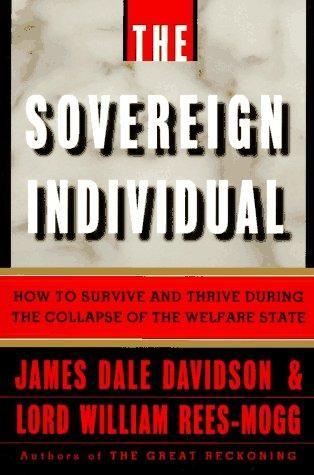
The Sovereign Individual: How to Survive and Thrive During the Collapse of the Welfare State
by
James Dale Davidson
and
William Rees-Mogg
Published 3 Feb 1997
In the Industrial Age, Hong Kong had no need to be a democracy, as it was spared the unpleasant necessity of gathering resources to support a formidable military establishment. Hong Kong was defended from the outside, so it could afford to maintain a really free economy. It was precisely the capacity to rake in resources that made democracy supreme during the megapolitical conditions of the Industrial Age. Mass democracy went hand in hand with industrialism. As Alvin Toffler has said, mass democracy "is the political expression of mass production, mass distribution, mass consumption, mass education, mass media, mass entertainment, and all the rest."4 Now that information technology is displacing mass production, it is logical to expect the twilight of mass democracy.
…
You can now go into a store and purchase blue jeans that will be cut from a pattern customized to your measurements and sewn up half a world away. When new institutions at last evolve to fit the new megapolitical realities of the Information Age, you will be able to obtain governance at least as well customized to meet your personal needs and tastes as blue jeans. Alvin Toffler, of all people, has criticized the idea that information technology could make citizens into customers. Toffler says, wrongly we believe, "That is far too narrow of a model. Whether we like it or not, there is a world of religion and feeling out there that cannot be simply reduced to contractual relationships."
…
But to say that is not to argue that it is impossible, much less that it would be a bad arrangement. A little less irrational gusto in nationalism could save millions of lives. "Entry, Exit" and "Voice" Of course, the commercialization of sovereignty is an unfamiliar concept, apparently even to Alvin Toffler. But its central idea-the economic mode of expression-is commonplace in the lives of people living at the end of the twentieth century. In any marginally free economy, consumers can act to express their desires directly by purchasing services and products. Or by withdrawing their custom. When you become dissatisfied with one version of a product or a provider of a service, you can directly express your dissatisfaction by means of "exit."

Stealing Fire: How Silicon Valley, the Navy SEALs, and Maverick Scientists Are Revolutionizing the Way We Live and Work
by
Steven Kotler
and
Jamie Wheal
Published 21 Feb 2017
To understand this possibility, it’s helpful to understand a few of the developments that have led to today’s marketplace. At the tail end of the twentieth century, we started moving from the selling of ideas,36 the so-called information economy, toward the selling of feelings, or what author Alvin Toffler called the “experience economy.” This is why retail shops started to look like theme parks. Why, instead of stocking ammo on their shelves like Wal-Mart, the outdoor retailer Cabela’s turns their stores into a hunter’s paradise of big-game mounts, faux mountainsides, and giant aquariums. It’s how Starbuck’s can charge four dollars for a fifty-cent cup37 of coffee: because they’re providing that cozy “third place” between work and home.
…
In 2007, a collection of the world’s biggest brands: Martin Lindstrom, Buyology: The Truth and Lies About Why We Buy (New York: Crown Business, 2010), p. 12. 34. discovered that product placement: Ibid., p .14. 35. no discernible way’: Ibid., p. 126. 36. At the tail end of the twentieth century: Alvin Toffler, Future Shock (New York: Bantam, 1984), p. 221. 37. It’s how Starbuck’s: Matthew Dollinger, “Starbucks, ‘The Third Place,’ and Creating the Ultimate Customer Experience,” Fast Company, June 11, 2008. 38. were at the Advertising Research Foundation: B. Joseph Pine II and James H. Gilmore, The Experience Economy (Boston: Harvard Business Review Press, 2011), p. 255. 39.

Ten Billion Tomorrows: How Science Fiction Technology Became Reality and Shapes the Future
by
Brian Clegg
Published 8 Dec 2015
Brunner uses the computer’s ability to combine ultrafast communication and data processing to transform the nature of democracy, making government something that resembles a cross between online polls and a casino, with its collation of human responses and betting odds. The book’s title is a reference to Alvin Toffler’s stodgy 1970 work of futurology, Future Shock. While Toffler has proved pretty well universally wrong when it comes to the real world, his ideas were much followed at the time and proved a great inspiration for fiction writers. In this case the concept is built on the Delphi method, originated by the RAND Corporation in the 1950s.
…
Lenat section, “From 2001 to 2001: Common Sense and the Mind of HAL” in David G. Stork (ed.), Hal’s Legacy (Cambridge, MA: MIT Press, 2000), pp. 193–94. The novel featuring a Delphi-based government is John Brunner, Shockwave Rider (London: Dent, 1975). The work of futurology that inspired Shockwave Rider is Alvin Toffler, Future Shock (London: Pan Books, 1970). 18. NEVER-ENDING STORY Information on space elevators and the difficulties in constructing them from Brian Clegg, Final Frontier (New York: St. Martin’s Press, 2014), pp. 61–65. INDEX The index that appeared in the print version of this title does not match the pages in your e-book.

The Rationalist's Guide to the Galaxy: Superintelligent AI and the Geeks Who Are Trying to Save Humanity's Future
by
Tom Chivers
Published 12 Jun 2019
‘But that’s what they insisted they call everything.’ Humanity+ had a more left-wing, less utopian approach to the future. Yudkowsky, on the other hand, felt that the problem with the Extropians was a lack of ambition. He set up an alternative, the SL4 mailing list. SL4 stands for (Future) Shock Level 4; it’s a reference to the 1970 Alvin Toffler book Future Shock.12 Future shock is the psychological impact of technological change; Toffler describes it as a sensation of ‘too much change in a short period of time’. Yudkowsky took the concept further, dividing it up into ‘levels’ of future shock, or rather into people who are comfortable with different levels of it.
…
Eliezer Yudkowsky, My life so far, August 2000 http://web.archive.org/web/20010205221413/http://sysopmind.com/eliezer.html#timeline_great 10. William Saletan, ‘Among the Transhumanists’, Slate, 4 June 2006 https://web.archive.org/web/20061231222833/http://www.slate.com/id/2142987/fr/rss/ 11. Quoted in Bostrom, ‘A History of Transhumanist Thought’, p. 14 12. Alvin Toffler, Future Shock (Turtleback Books, 1970) 13. Eliezer Yudkowsky, ‘Future shock levels’, SL4 archives, 1999 http://sl4.org/shocklevels.html 14. Eliezer Yudkowsky, ‘The plan to Singularity’, 2000 http://yudkowsky.net/obsolete/plan.html 15. ‘Re: the AI box experiment’, SL4 archives, 2002 http://www.sl4.org/archive/0203/3141.html 16.

Utopias: A Brief History From Ancient Writings to Virtual Communities
by
Howard P. Segal
Published 20 May 2012
If anything, science and technology policy are today more political and more ideological in nature than ever before in American history.42 Still, it was ironic that the assault on the OTA was led by then House Speaker Newt Gingrich. Not only had Gingrich deemed himself a high-tech visionary and admirer of gurus Alvin and Heidi Toffler, but it was Alvin Toffler’s bestselling Future Shock (1970) that, for all its flaws, made millions of readers aware of the need to anticipate the future more systematically than had ever been attempted before. The disappearance of the OTA hardly contributed to this effort. That a self-proclaimed leading policy-maker like Gingrich, with a Ph.D. in history to boot, had pushed for its disappearance appeared to make no intellectual sense.
…
Stukel, then president of the multi-campus University of Illinois, entitled “The Future of Land Grant Universities” but relevant to public (and, to a lesser extent, private) universities in general. Stukel was a long-time engineering professor at that institution before moving into administration. He served as president from 1995 to 2005. In the tradition of Alvin Toffler, Stukel invokes the metaphor of the wave in describing high tech. The wave of the future is the technological imperative taken to an extreme, for one either rides it out and, to this extent, controls one’s destiny, or else drowns. There is no middle ground. It is the application of Fuller’s Utopia or Oblivion.

Ghost Road: Beyond the Driverless Car
by
Anthony M. Townsend
Published 15 Jun 2020
It’s a challenging prospect to make sense of. As we have seen, the way we shop has changed many times. But nothing in our past experience has prepared us for the size and suddenness of this shift. This is the stuff of future shock—that psychological state of “shattering stress and disorientation” that futurist Alvin Toffler described arising from “too much change in too short a period of time.” Many of us are already struggling to keep up. I’m old enough to remember life before e-commerce, before credit cards for kids, and even before package tracking. As a teenager, I’d send my money orders (gasp!) off to mail-order catalog shops.
…
That Should Be Keeping Retailers Up at Night,” CNBC, March 19, 2019, https://www.cnbc.com/2019/03/19/heres-why-retailers-should-be-scared-of-amazon-dominating-e-commerce.html. 118its share is growing: “Top 10 US Companies, Ranked by Retail Ecommerce Sales Share, 2018 (% of US Retail Ecommerce Sales),” eMarketer, July 17, 2018, https://www.emarketer.com/Chart/Top-10-US-Companies-Ranked-by-Retail-Ecommerce-Sales-Share-2018-of-US-retail-ecommerce-sales/220521. 118Amazon is worth more than three times: Erica Pandey, “On the Mind of Every Retail CEO: The Amazon Threat,” Axios, September 19, 2018, https://www.axios.com/amazon-strategy-shopify-flipkart-macys-code-commerce-1e1a5fae-75b0-4a68-b308-9ca1a539437d.html. 118Alibaba has a similar market share: “2019: China to Surpass US.” 118half of all parcel shipments in the US: Tim Laseter, Andrew Tipping, and Fred Duiven, “The Rise of the Last-Mile Exchange,” Strategy + Business, July 30, 2018, https://www.strategy-business.com/article/The-Rise-of-the-Last-Mile-Exchange. 119Alibaba delivered one billion shipments: Lisa Lacy, “Alibaba Rings Up $30.8 Billion on Singles Day 2018,” Adweek, November 11, 2018, https://www.adweek.com/digital/alibaba-rings-up-30-8-billion-on-singles-day-2018/. 119million-person courier team: Rita Liao, “Alibaba and Amazon Move Over, We Visited JD’s Connected Grocery Store in China,” TechCrunch, November 15, 2018, https://techcrunch.com/2018/11/15/jd-7fresh-supermarket/. 119spent more than $20 billion on shipping: Alana Semuels, “Free Shipping Isn’t Hurting Amazon,” The Atlantic, April 27, 2018, https://www.theatlantic.com/technology/archive/2018/04/free-shipping-isnt-hurting-amazon/559052/. 11910 percent of its total take: Daphne Howland, “Amazon Captured 44% of US Online Sales Last Year,” Retail Dive, January 4, 2018, https://www.retaildive.com/news/amazon-captured-44-of-us-online-sales-last-year/514044/. 119same-day delivery is still very limited: Julian Allen, Maja Piecyk, and Marzena Piotrowska, An Analysis of the Same-Day Delivery Market and Operations in the UK, Technical Report CUED/C-SRF/TR012 (Westminster, UK: University of Westminster, November 2018), 10. 119consumers will expect all deliveries: McKinsey & Company, An Integrated Perspective on the Future of Mobility (McKinsey Center for Future Mobility, October 2016), 3. 120“too much change in too short a period of time”: Alvin Toffler, Future Shock (New York: Random House, 1970). 120receives five deliveries each week, twice as many: N. McGuckin and A. Fucci, Summary of Travel Trends: 2017 National Household Travel Survey, Report No. FHWA-PL-18-019 (Washington, DC: Federal Highway Administration, July 2018), 100. 121schlepp stuff into the surrounding territory: Joann Muller, “One Big Thing: The Rise of Driverless Delivery,” Axios, November 28, 2018, https://www.axios.com/autonomous-vehicles-could-be-used-for-deliveries-3fb12a24-3e66-4d8b-b678-a2fbb47d05cb.html. 121By 2020 fully two-thirds will be: Laseter et al., “The Rise of the Last-Mile Exchange.” 122more than twice as many shipments: Laseter et al., “The Rise of the Last-Mile Exchange.” 122exhausted racers mustered what energy they could: Dan Peterson, “Why Are Marathons 26.2 Miles Long?”
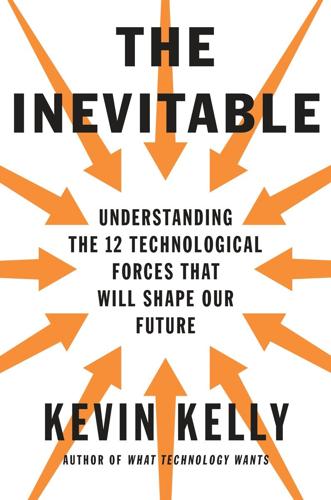
The Inevitable: Understanding the 12 Technological Forces That Will Shape Our Future
by
Kevin Kelly
Published 6 Jun 2016
Naturally, the producer cherishes this kind of loyalty, but the customer gets (or should get) many advantages for continuing as well: uninterrupted quality, continuous improvements, attentive personalization—assuming it’s a good service. Access mode brings consumers closer to the producer, and in fact the consumer often acts as the producer, or what futurist Alvin Toffler called in 1980 the “prosumer.” If instead of owning software, you access software, then you can share in its improvement. But it also means you have been recruited. You, the new prosumer, are encouraged to identify bugs and report them (replacing a company’s expensive QA department), to seek technical help from other customers in forums (reducing a company’s expensive help desk), and to develop your own add-ons and improvements (replacing a company’s expensive development team).
…
from $1.64 in 1977 to $3.58 in 2000: Figures adjusted for inflation. Ronald Bailey, “Dematerializing the Economy,” Reason.com, September 5, 2001. “Software eats everything”: Marc Andreessen, “Why Software Is Eating the World,” Wall Street Journal, August 20, 2011. Toffler called in 1980 the “prosumer”: Alvin Toffler, The Third Wave (New York: Bantam, 1984). subscribe to Photoshop: “Subscription Products Boost Adobe Fiscal 2Q Results,” Associated Press, June 16, 2015. Uber for laundry: Jessica Pressler, “‘Let’s, Like, Demolish Laundry,’” New York, May 21, 2014. Uber for doctor house calls: Jennifer Jolly, “An Uber for Doctor House Calls,” New York Times, May 5, 2015.
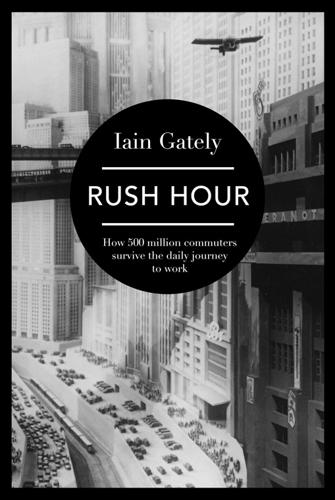
Rush Hour: How 500 Million Commuters Survive the Daily Journey to Work
by
Iain Gately
Published 6 Nov 2014
Nilles further acknowledged that telecommuting would not be perfect for executives who, in accordance with management theories of the era, needed ‘face-to-face meetings to renew confidence in verbal cues, perceptions of attitudes, and similar imponderables not easily transmitted’ over telephones. Finally, he warned that there would be consequences for labour: if the unions and the courts decided that making people telecommute looked too much like divide and rule, then they would resist it tooth and nail. Alvin Toffler was the next futurist after Nilles to back telecommuting. In his book The Third Wave (1980), he split civilization into three eras or waves: (a) agricultural; (b) industrial and (c) the coming one of information. Toffler was convinced that the third wave had arrived (‘A new civilization is bursting into being in our midst!’)
…
CHAPTER XIII Virtual Journeys 282 ‘We are entering an era of electronically extended bodies’, William Mitchell, City of Bits: Space, Place and the Infobahn, Cambridge, Mass., MIT Press, 1994; http://mitpress2.mit.edu/ebooks/City_of_Bits/Getting_to_the_Good_Bits/1994Telepresence.html. 283 ‘enable employees of large organizations’, Jack Nilles, ‘Telecommunications and Organizational Decentralization’, IEEE Transactions on Communications, vol. COM-23, no. 10, October 1975. 285 For ‘A new civilization is bursting into being in our midst!’, Alvin Toffler, ‘The Electronic Cottage’, 14 October 1981, see: http://www.embedded.com/print/4319730. 288 ‘counting teleworkers is like measuring a rubber band’, Lars Qvortrup quoted in Paul J. Jackson and Jos M. van der Wielen (eds), Teleworking: International Perspectives. From Telecommuting to the Virtual Organisation, London, Routledge, 1998, p. 21. 289 ‘In the late ’90s my favorite line at the beginning of a presentation’, Ruth David, ‘The Father of Indian Outsourcing’, Forbes, 29 May 2007: http://www.forbes.com/2007/ 05/21/outsourcing-raman-india-oped-cx_rd_0522raman.html. 291 ‘Tell an American that your name is Raja’, Chris Walker and Morgan Hartley, ‘The Culture Shock of India’s Call Centers’, Forbes, 16 December 2012: http://www.forbes.com/sites/morganhartley/2012/12/16/the-culture-shock-of-indias-call-centers/. 291 ‘I don’t know what Wales is’, Daily Mail, 28 April 2014: http://www.dailymail.co.uk/news/article-2270536/Wales-heard-What-Welsh-BT-customer-told-spoke-centre-worker-India.html. 292 For ‘IBM was one of the first global companies’, see: http://www.ibm.com/ibm/environment/climate/commuting.shtml. 292 For IBM headcount secrecy, see: http://www.computerworld.com/s/article/9169678/IBM_stops_disclosing_U.S.

The Future of Money
by
Bernard Lietaer
Published 28 Apr 2013
However, as breakdowns and crises spread to many domains (e.g. global monetary system, government, education, environment, jobs, etc.) if the transition towards an information economy becomes indeed an 'Age of Uncertainty’ then the time is ripe to reconsider the old organisational assumptions. Under such circumstances, holding on to the old expert-driven, hierarchical command and control structures will predictably kill the very innovations that the circumstances require. Tony Judge, whom Alvin Toffler described as 'one of our most brilliant organisation theorists', claims that the organisations of the future will take the form of' networks not co-ordinated by anybody; the participating bodies co-ordinate themselves'. The first large-scale contemporary implementation of such principles was accomplished by Dee Hock, when he founded the VISA credit card system in the 1970s.298 VISA has grown spectacularly to become the largest business organisation in the world: it has a sales volume of 81.3 trillion per year and serves 600 million clients.
…
In contrast, Careful Communities is an 'excess Yin' deviation where concerns about community cohesion have taken over when a monetary meltdown triggers widespread socio-economic disarray. Finally, Hell on Earth occurs when no faction in society fills in the power vacuum left after a monetary crash. Alvin Toffler claimed: 'What appears to be emerging is neither a corporate dominated future nor a global government, but a far more complex system ... We are moving toward a world system composed of units densely interrelated like the neurons in a brain rather than organised like the departments of a bureaucracy.'
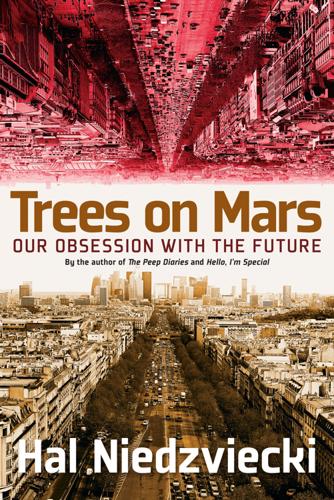
Trees on Mars: Our Obsession With the Future
by
Hal Niedzviecki
Published 15 Mar 2015
Our minds are throwing in the towel, waving the white flag. And so the age of anxiety, exponentially expanding with each fresh push to emphasize change and future over constancy and progression. Chasing the future isn’t saving us, it’s killing us. ° ° ° ° ° ° We’re in the forty-fifth year of future shock. The book Future Shock, by Alvin Toffler (with contributions from his wife, Heidi), has endured since its publication in 1970, selling six million-plus copies all over the world. Future Shock captured the feeling and sensibility of an era in transition from the progressive shared futurism embedded in the nationalist project to the cutthroat techno-individualism we are familiar with today.
…
Stephanie Nolan, “Suicide among India’s Young Adults at ‘crisis’ Levels,” The Globe and Mail, June 21, 2012, http://www.theglobeandmail.com/news/world/suicide-among-indias-young-adults-at-crisis-levels/article4362016/. 15. Lorianna De Giorgio, “What Chronic Stress Does to Your Brain,” The Toronto Star, July 15, 2012, http://www.thestar.com/news/world/article/1225370--what-chronic-stress-does-to-your-brain. 16. Alvin Toffler, Future Shock (New York: Bantam Books, 1990). 17. Ibid., 2. 18. Toffler, Future Shock. 19. Ibid. 20. Ibid., 375. 21. Ibid., 379. 22. Ibid., 377. 23. Toffler, Future Shock. 24. Ibid., 379. 25. Moretti, The New Geography of Jobs, 33. 26. Edgerton, The Shock of the Old. 27. Lucas Mearian, “IBM Smashes Moore’s Law, Cuts Bit Size to 12 Atoms,” Computerworld, January 12, 2012, http://www.computerworld.com/article/2501259/data-center/ibm-smashes-moore-s-law--cuts-bit-size-to-12-atoms.html. 28.
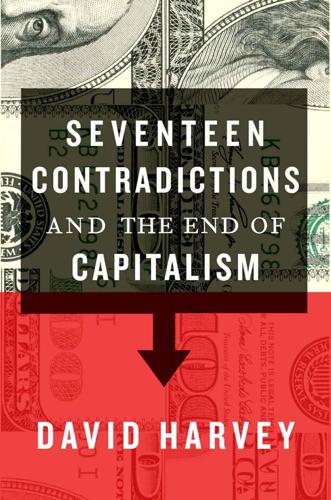
Seventeen Contradictions and the End of Capitalism
by
David Harvey
Published 3 Apr 2014
All of these forms can be instantaneously consumed even as they absorb vast amounts of what might otherwise be free time. The consumers, furthermore, produce information, which is then appropriated by the owners of the media for their own purposes. The public is simultaneously constituted as both producers and consumers, or what Alvin Toffler once called ‘prosumers’.10 There is an important corollary here and this broaches a theme that we will encounter elsewhere: capital profits not through investing in production in these spheres but by appropriating rents and royalties on the use of the information, the software and the networks it constructs.
…
Thomas Malthus, An Essay on the Principle of Population, Cambridge, Cambridge University Press, 1992. 8. McKinsey Global Institute, ‘The World at Work: Jobs, Pay and Skills for 3.5 Billion People’, Report of the McKinsey Global Institute, 2012. 9. Guy Debord, The Society of the Spectacle, Kalamazoo, Black & Red, 2000. 10. Alvin Toffler, The Third Wave: The Classic Study of Tomorrow, New York, Bantam, 1980. 11. Michael Hardt and Antonio Negri, Commonwealth, Cambridge, MA, Harvard University Press, 2009. 12. Antonio Gramsci, The Prison Notebooks, London, NLR Books, 1971. 13. Gordon, ‘Is U.S. Economic Growth Over?
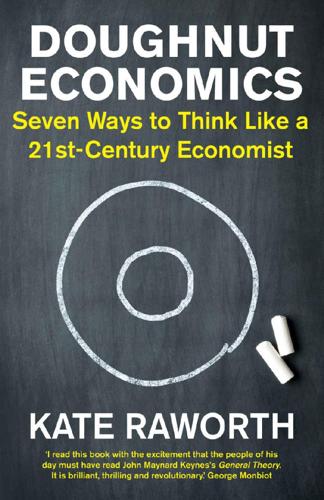
Doughnut Economics: Seven Ways to Think Like a 21st-Century Economist
by
Kate Raworth
Published 22 Mar 2017
Humanity faces some formidable challenges, and it is in no small part thanks to the blind spots and mistaken metaphors of outdated economic thinking that we have ended up here. But for those who are ready to rebel, look sideways, to question and think again, then these are exciting times. ‘Students must learn how to discard old ideas, how and when to replace them … how to learn, unlearn, and relearn,’ wrote the futurist Alvin Toffler.22 This could not be more true for those seeking economic literacy: now is a great moment for unlearning and relearning the fundamentals of economics. The power of pictures Everybody’s saying it: we need a new economic story, a narrative of our shared economic future that is fit for the twenty-first century.
…
By largely ignoring the core economy, mainstream economics has also overlooked just how much the paid economy depends upon it. Without all that cooking, washing, nursing and sweeping, there would be no workers – today or in the future – who were healthy, well-fed, and ready for work each morning. As the futurist Alvin Toffler liked to ask at smart gatherings of business executives, ‘How productive would your workforce be if it hadn’t been toilet trained?’32 The scale of the core economy’s contribution is not to be dismissed lightly, either. In a 2002 study of Basle, a wealthy Swiss city, the estimated value of unpaid care being provided in the city’s households exceeded the total cost of salaries paid in all of Basle’s hospitals, daycare centres and schools, from the directors to the janitors.33 Likewise, a 2014 survey of 15,000 mothers in the USA calculated that, if women were paid the going hourly rate for each of their roles – switching between housekeeper and daycare teacher to van driver and cleaner – then stay-at-home mums would earn around $120,000 each year.
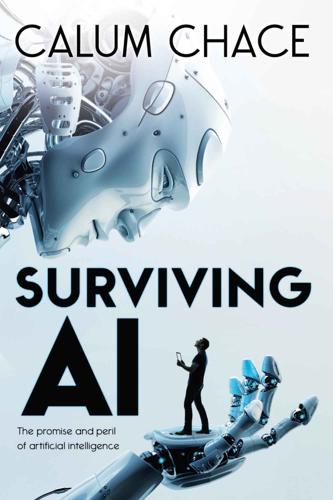
Surviving AI: The Promise and Peril of Artificial Intelligence
by
Calum Chace
Published 28 Jul 2015
In the last year, awareness that advanced AI brings both immense promise and immense peril has become widespread. I’m sure that both Kurzweil and Bostrom would freely admit that, like Newton, they saw further than others because they stood on the shoulders of giants – in their cases people like Hans Moravic, Vernor Vinge and Alvin Toffler. There seems little point trying to pin down the exact source of each and every innovative idea our species has had: we can just be grateful that we do have them. Those of us who have been thinking about these things for years have long felt there needed to be a global debate about the future of artificial intelligence.

Distrust That Particular Flavor
by
William Gibson
Published 3 Jan 2012
Noting these two pieces of more or less simultaneous news, I also noted that my imagination, which grew up on countless popular imaginings of exactly this sort of thing, could produce nothing better in response than a tabloid headline: SYNTHETIC BACTERIA IN QUANTUM FREE-SPACE TELEPORTATION SHOCKER. Alvin Toffler warned us about Future Shock, but is this Future Fatigue? For the past decade or so, the only critics of science fiction I pay any attention to, all three of them, have been slyly declaring that the Future is over. I wouldn’t blame anyone for assuming that this is akin to the declaration that history was over, and just as silly.

On the Move: Mobility in the Modern Western World
by
Timothy Cresswell
Published 21 May 2006
It is the fact of locomotion . . . that defines the very nature of society. But in order that there may be any permanence and progress in society the individuals who compose it must be located . . .”39 This strand of thinking about mobility as a pathological threat to society became a consistent thread in American social commentary. In 1970 the popular sociologist Alvin Toffler wrote the hugely successful Future Shock in which he prepared the citizens of the world for a future world of runaway mobility.40 Here he describes a world in which everything is accelerating. Science, technology, and culture were all speeding up. In many ways this was George Beard nearly one hundred years later—Toffler appears to be breathlessly describing a late-twentieth-century version of neurasthenia.
…
Anderson, The Trends of Urban Sociology, 14. 39. Robert Park, “The Mind of the Hobo: Reflections Upon the Relation between Mentality and Locomotion,” in The City: Suggestions for Investigation of Human Behavior in the Urban Environment, ed. Robert Park and Ernest Burgess (Chicago: University of Chicago Press, 1925), 156–60, 159. 40. Alvin Toffler, Future Shock (New York: Random House, 1970). 41. Ibid., 35. 42. Ibid., 75. 43. Ibid., 77. 44. Ibid., 90. 45. Marc Augé, Non-Places: Introduction to an Anthropology of Supermodernity (London; New York: Verso, 1995); Paul Virilio, Speed and Politics: An Essay on Dromology, Semiotext(e) (New York: Columbia University, 1986). 46.

Imaginable: How to See the Future Coming and Feel Ready for Anything―Even Things That Seem Impossible Today
by
Jane McGonigal
Published 22 Mar 2022
I’m excited to go on this journey with you. Before we begin, let me share one more thing—it’s my favorite maxim of professional futures thinking: In dealing with the future . . . it is more important to be imaginative and insightful than to be one hundred percent “right.”7 This bit of wisdom comes from Alvin Toffler, author of the 1970 book Future Shock, which kicked off professional futures thinking as we know it today. Toffler proposed the idea that society occasionally experiences a period of profound and sustained change previously so unthinkable that the people who live through it suffer a kind of “future shock.”
…
Women Have Dropped Out of the Labor Force in the Past Year,” CBS News, February 5, 2021, https://www.cbsnews.com/news/covid-crisis-3-million-women-labor-force/. 4 Rabail Chaudhry et al., “A Country Level Analysis Measuring the Impact of Government Actions, Country Preparedness and Socioeconomic Factors on COVID-19 Mortality and Related Health Outcomes,” EClinicalMedicine 25 (August 1, 2020): 100464, https://doi.org/10.1016/j.eclinm.2020.100464. 5 Bryan Walsh, “SARS Made Hong Kong and Singapore Ready for Coronavirus,” Axios, March 25, 2020, https://www.axios.com/sars-hong-kong-and-singapore-ready-for-covid-19-46444868-2550-4d90-ab92-a3cc90635cb4.html. 6 Karen Attiah, “Africa Has Defied the Covid-19 Nightmare Scenarios. We Shouldn’t Be Surprised,” Washington Post, September 22, 2020, https://www.washingtonpost.com/opinions/2020/09/22/africa-has-defied-covid-19-nightmare-scenarios-we-shouldnt-be-surprised/. 7 Alvin Toffler, Future Shock (New York: Random House, 1970). 8 Arundhati Roy, “The Pandemic Is a Portal,” Financial Times, April 3, 2020, https://www.ft.com/content/10d8f5e8-74eb-11ea-95fe-fcd274e920ca. 9 Barbara Freeman and Robert Hawkins, “Evoke—Developing Skills in Youth to Solve the World’s Most Complex Problems: Randomized Impact Evaluation Findings,” World Bank Education, Technology and Innovation: SABER-ICT Technical Paper Series no. 19 (Washington, DC: World Bank, 2017), https://openknowledge.worldbank.org/handle/10986/29167.
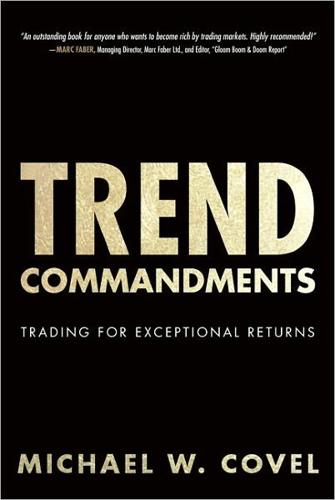
Trend Commandments: Trading for Exceptional Returns
by
Michael W. Covel
Published 14 Jun 2011
Michael Gibbons quoted in Michael Covel’s “‘Why’ Doesn’t Matter to the Technical Trader.” SFO Magazine, April 24, 2007. 2. Jeff Zucker, former CNBC CEO. See http://www.newsweek.com/2007/08/13/forward-into-battle.html. 3. See http://www.thefinancialphilosopher.com/2011/02/understanding-markets-naturenot-naivety-or-narcissism.html. Snow Job 1. Alvin Toffler. 2. Jim Rohrbach blog post in response to “Trend Following is not Fundamental Analysis.” January 28, 2011. See http://www.michaelcovel.com/2011/01/28/trend-followingis-not-fundamental-analysis/. Twit Me a River 1. See http://www.citywire.co.uk/global/can-you-make-money-from-twitter/a479038?.

Futureproof: 9 Rules for Humans in the Age of Automation
by
Kevin Roose
Published 9 Mar 2021
Another fascinating 1980s automation book, this time about Japan and its culture of relentless factory roboticization. You Look Like a Thing and I Love You by Janelle Shane (2019). A great primer, written by a prominent AI researcher, and one of the only books about machine learning that has ever made me laugh. Future Shock by Alvin Toffler (1970). The book that kicked off the futurist craze, and still one of the best examples of writing about the psychological effects of technological change. The Human Use of Human Beings by Norbert Wiener (1950). An examination of the morality of machines, written by one of my all-time favorite technological thinkers.

The Purpose Economy: How Your Desire for Impact, Personal Growth and Community Is Changing the World
by
Aaron Hurst
Published 31 Aug 2013
The Impact Hub, for example, has created spaces all over the world to encourage collaboration and support for professionals who seek to create organizations that improve the human condition. These spaces are open and designed to build community and inspire innovation, and they have been growing explosively. The New York Times recently pointed out that although the dream of working independently in our own homes has been gaining in popularity, ever since Alvin Toffler introduced the notion of the “electronic cottage” in his book The Third Wave, many of these home workers have found the isolation alienating and are looking for more connection and interaction. NeueHouse, a new “co-working” space in Manhattan, is a mash-up of a private club and an open office space.
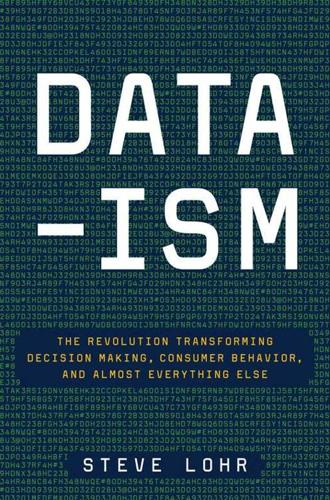
Data-Ism: The Revolution Transforming Decision Making, Consumer Behavior, and Almost Everything Else
by
Steve Lohr
Published 10 Mar 2015
But the data paradox is that a world richer and richer in data has so far yielded little payoff in most fields. The supply of data races ahead, while the ability to use it lags badly. To see the data paradox writ large, let’s return to the intensive care ward at the Emory University Hospital in Atlanta. The term “information overload” dates back at least to the 1960s, and the futurist Alvin Toffler popularized the phrase in his 1970 best seller Future Shock. Yet it seems a quaint understatement to Dr. Timothy Buchman as he surveys the twenty-room intensive care unit, where the hundreds of electronic medical devices are throwing off 160,000 data points a second. In the glassed-in rooms, there is so much medical machinery, so many respirators, pumps, kidney machines, and monitors for every vital sign and major organ, that it can be hard to see the patient.
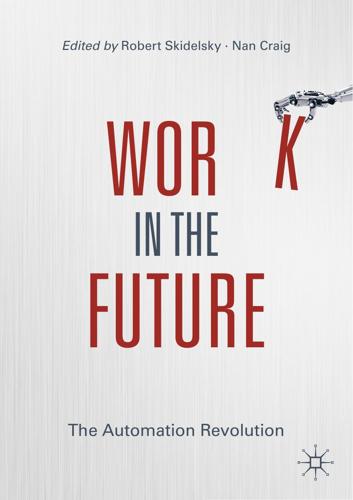
Work in the Future The Automation Revolution-Palgrave MacMillan (2019)
by
Robert Skidelsky Nan Craig
Published 15 Mar 2020
I know one person (Win McCormack) who was taking part in think tanks at the time, and he told me that all the Ivy League schools in America were organizing, “what are we going to do when all the jobs are gone, and the working class is thrown out of work.” The Player Piano scenario felt quite imminent at that time. Then around 1971 or 1972 you get things like Future Shock by Alvin Toffler coming out which gives public voice to all this; Toffler makes an argument about what he calls “accelerative thrust,” that the speed at which technological change is happening is geometrical: the number of new patents, energy use, and so forth (Toffler 1970). For instance, if you look at the speed at which the fastest person can travel, for example at that time, and it did seem to be increasing at such a rate that it was reasonable to assume that by now, we should be exploring other solar systems.

Daily Rituals: How Artists Work
by
Mason Currey
Published 22 Apr 2013
Vladimir Nabokov: Vladimir Nabokov, Strong Opinions (1973; repr. New York: Vintage International, 1990); Vladimir Nabokov, “Nabokov on Nabokov and Things,” New York Times, May 12, 1968, http://www.nytimes.com/books/97/03/02/lifetimes/nab-v-things.html. 471. “I generally start”: Interview with Alvin Toffler, Playboy, 1963, in Strong Opinions, 29. 472. “I awake around”: Ibid., 28–9. 473. “My habits are simple”: Interview with Allene Talmey, Vogue, 1969, in Strong Opinions, 157. 474. “soccer matches”: Interview with Kurt Hoffman in Strong Opinions, 191. 475. “I sleep even worse”: “Nabokov on Nabokov and Things.” 476.

Aerotropolis
by
John D. Kasarda
and
Greg Lindsay
Published 2 Jan 2009
Prior to flight, humans always balanced mobility with domesticity, venturing farther and farther afield while picking up speed, although never straying too far from home. The size and shape of cities evolved in turn, but our daily lives stayed rooted in them. Road warriors said goodbye to all that, commuting halfway across the country for lunch and back in time for dinner. This rupture of time and space was shocking at first, leading the sociologist Alvin Toffler to pronounce that “never in history has distance meant less. Never has man’s relationship with place been more numerous, fragile, and temporary … We are breeding a new race of nomads.” They’re a tribe of mostly middle-aged men, married without children and earning a median salary of $78,700. Their time, as calculated by Brookings, is worth an inflation-adjusted $67 an hour.
…
His idiom is a mash-up of consultant-speak and academic jargon, each one wielded to differing but complementary effect. He hammers home his collection of catchphrases like a good thought-leader should. “The Web can’t move a box,” “business is a contact sport,” and “never make strategic decisions on a cyclical basis.” And then there’s “survival of the fastest,” poached from Alvin Toffler. “My favorite book of his is Powershift, published in 1990,” Kasarda told the room. “It’s a five-hundred-eighty-five-page treatise asking what will define the next hierarchy of countries, of companies, of regions and communities. It can be boiled down to three words: speed, speed, and speed. It wouldn’t be the big eating the small, but the fast eating the slow.
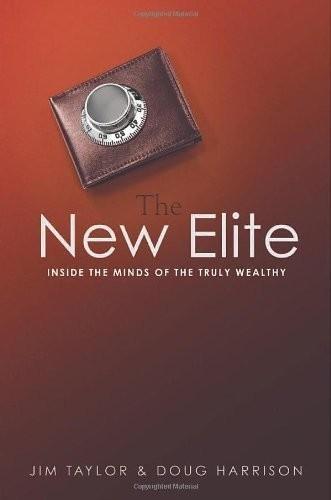
The New Elite: Inside the Minds of the Truly Wealthy
by
Dr. Jim Taylor
Published 9 Sep 2008
Through the gravitational pull of wealth (and, some would say, unfairly government-supported monopolies), his net worth is estimated to have risen from $20 billion to $60 billion in just two years. Still, he’s known for his thrifty lifestyle, doesn’t use a computer, and is proud of the fact that he owns no homes outside of Mexico. The Wall Street Journal quoted author and friend Alvin Toffler as saying of Slim: ‘‘If you didn’t know he was the richest guy in the world, you’d just think he was a likable and intelligent guy.’’ 160 The New Elite India now boasts four of the ten richest people in the world, up from just one in 2007, led by steel magnate Lakshmi Mittal (number four globally with an estimated net worth of $45 billion).
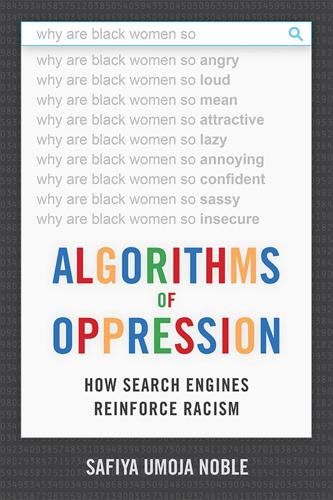
Algorithms of Oppression: How Search Engines Reinforce Racism
by
Safiya Umoja Noble
Published 8 Jan 2018
See Rifkin, 1995. 25. The term “prosumer” is a portmanteau of “producer” and “consumer” that is often used to indicate a higher degree of digital literacy, economic participation, and personal control over the means of technology production. The term is mostly attributed, in this context, to Alvin Toffler, a futurist who thought that the line between traditional economic consumer and producer would eventually blur through engagements with technology and that this participation would generally lead to greater mass customization of products and services by corporations. See Toffler, 1970, 1980; Tapscott, 1996; Ritzer and Jurgenson, 2010. 26.

Tomorrow's Capitalist: My Search for the Soul of Business
by
Alan Murray
Published 15 Dec 2022
After leaving AOL, Case started the venture capital company Revolution, focused on entrepreneurs, which he believes are the engines of future prosperity and the key to the revival of communities across the nation. In his 2016 book, The Third Wave: An Entrepreneur’s Vision of the Future, named as an homage to the futurist Alvin Toffler’s groundbreaking 1980 book with a similar name, Case wrote that the first wave was getting people online, the second wave was adding connection through search and social media functions, and “the Third Wave of the Internet is coming, the moment where the Internet transforms from something we interact with to something that interacts with everything around us.

Age of the City: Why Our Future Will Be Won or Lost Together
by
Ian Goldin
and
Tom Lee-Devlin
Published 21 Jun 2023
The first to systematically explore its potential in the modern world was the US physicist Jack Nilles, who in 1976 published a book titled The Telecommunications–Transportation Tradeoff.1 Writing against a backdrop of soaring oil prices and growing excitement about the personal computer, Nilles argued that society was approaching a tipping point. Once the cost of telecommunications equipment fell below the cost of commuting to work, which he forecast it would soon do, centralized offices would become a relic of the past. A few years later, the popular futurist Alvin Toffler echoed this prediction in his 1980 book The Third Wave.2 In a throwback to pre-industrial cottage industries, in which the manufacturing of products like textiles occurred within the worker’s own home, he imagined the ‘electronic cottage’ re-establishing the home as the focal point of work. The rapid growth of the internet in the 1990s further fuelled the belief that a large-scale transition to remote working was just over the horizon.

The Idea of Decline in Western History
by
Arthur Herman
Published 8 Jan 1997
According to a report published in 1980, economic development “involves a profound transformation of the entire economic and social structure” of a society, usually for the worse. Development was dislocating and disruptive, shattering “cultural identities” and leaving a trail of human wreckage behind it. One author, Alvin Toffler, coined a new phrase for its traumatic effects: “future shock.”*14 A new model of development was therefore needed, one that would lead not to “chaos” (meaning economic activity running beyond the control of government planners) but to stability as conceived by the late-liberal mind. In 1980, World Bank president Robert McNamara and former German Chancellor Willi Brandt assembled an Independent Commission on International Development Issues for UN Secretary Kurt Waldheim.† Although Paul Ehrlich’s dire predictions of twelve years earlier had failed to materialize, the commission’s mood had not improved: At the beginning of the 1980’s the world community faces much greater dangers than at any time since the Second World War.
…
The alternative to historical pessimism about the future of modern society is not optimistic complacency: they are opposite sides of the same holistic view. The alternative to cultural pessimism is not some sort of megatrend “third wave” or other futurological adventure of authors like Warren Wagar and Alvin Toffler. The classical liberal view originally sprang up precisely because its adherents recognized the dangers of insisting that individuals have significance only if they are part of a larger whole. In earlier times, that holisticorganic model had been “the great chain of being,” in which a person’s status was assigned by God and nature and enforced by political authority.
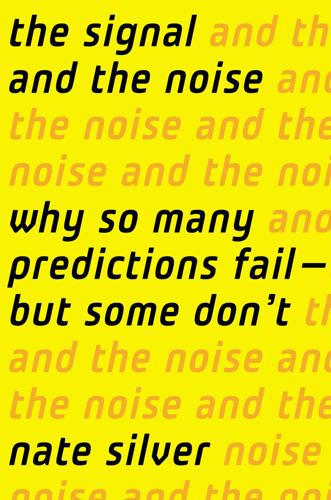
The Signal and the Noise: Why So Many Predictions Fail-But Some Don't
by
Nate Silver
Published 31 Aug 2012
The human brain is quite remarkable; it can store perhaps three terabytes of information.41 And yet that is only about one one-millionth of the information that IBM says is now produced in the world each day. So we have to be terribly selective about the information we choose to remember. Alvin Toffler, writing in the book Future Shock in 1970, predicted some of the consequences of what he called “information overload.” He thought our defense mechanism would be to simplify the world in ways that confirmed our biases, even as the world itself was growing more diverse and more complex.42 Our biological instincts are not always very well adapted to the information-rich modern world.
…
Brian Owens, “Reliability of ‘New Drug Target’ Claims Called into Question,” NewsBlog, Nature, September 5, 2011. http://blogs.nature.com/news/2011/09/reliability_of_new_drug_target.html. 41. This estimate is from Robert Birge of Syracuse University. http://www.sizes.com/people/brain.htm. 42. Alvin Toffler, Future Shock (New York: Bantam Books, 1990), p. 362. 43. “The Polarization of the Congressional Parties,” VoteView.com. http://voteview.com/political_polarization.asp. 44. Dan M. Kahan, et al., “The Polarizing Impact of Science Literacy and Numeracy on Perceived Climate Change Risks,” Nature Climate Change, May 27, 2012. http://www.nature.com/nclimate/journal/vaop/ncurrent/full/nclimate1547.html. 45.

Future Crimes: Everything Is Connected, Everyone Is Vulnerable and What We Can Do About It
by
Marc Goodman
Published 24 Feb 2015
International organized crime groups, rogue governments, and even terrorists are rapidly establishing their own data brokerages and bolstering their analytic capabilities in order to take full advantage of the single largest bonanza that has ever come their way, with frightening implications for us all. CHAPTER 6 Big Data, Big Risk Our technological powers increase, but the side effects and potential hazards also escalate. ALVIN TOFFLER On the evening of November 26, 2008, a sixty-nine-year-old man checked into room 632 at the luxurious Taj Mahal Palace hotel in Mumbai, India. The guest, K. R. Ramamoorthy, was visiting from Bangalore on a routine business trip. Little did he know that his life was about to change forever.
…
Sadly, the situation is about to get much worse as new generations of even more powerful technologies come online, further separating us from ever experiencing a reality that has not been in one shape or form intermediated by somebody else. Control, Alt, Deceit One of the definitions of sanity is the ability to tell real from unreal. Soon we’ll need a new definition. ALVIN TOFFLER In 1865, Congress passed legislation allowing the director of the U.S. Mint to add the motto “In God we trust” to all gold and silver coins minted for circulation. The line, originally drawn from the fourth stanza of “The Star-Spangled Banner,” has since become the official motto of the United States.
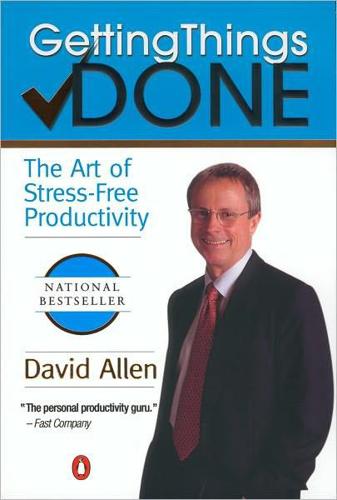
Getting Things Done: The Art of Stress-Free Productivity
by
David Allen
Published 31 Dec 2002
Part 2 of this book will provide specific coaching about how to use these three models for making action choices, and how the best practices for collecting, processing, planning, organizing, and reviewing all contribute to your greatest success with them. 3 Getting Projects Creatively Under Way: The Five Phases of Project Planning You’ve got to think about the big things while you’re doing small things, so that all the small things go in the right direction. —Alvin Toffler THE KEY INGREDIENTS of relaxed control are (1) clearly defined outcomes (projects) and the next actions required to move them toward closure, and (2) reminders placed in a trusted system that is reviewed regularly. This is what I call horizontal focus. Although it may seem simple, the actual application of the process can create profound results.

Protocol: how control exists after decentralization
by
Alexander R. Galloway
Published 1 Apr 2004
“No more vapor theory anymore,” wrote Geert Lovink. Vapor theory tends to ignore the computer itself. The computer is often eclipsed by that more familiar thing, information society. Mine is not a book about information society, but about the real machines that live within that society. Thus, my study skips direct engagement with the work of Alvin Toffler, Peter Drucker, Daniel Bell, and others who discuss the third phase of capitalist development in social terms. The large mass of literature devoted to artificial intelligence and speculations about the consciousness (or lack thereof ) within man and machine is also largely avoided in this book.
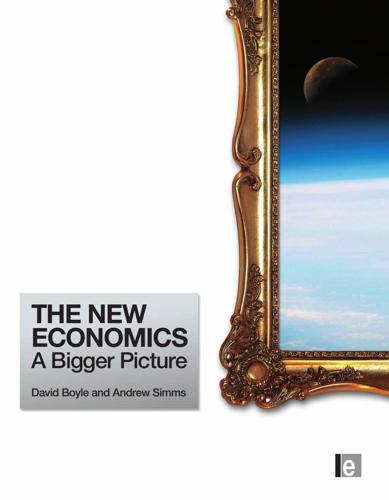
The New Economics: A Bigger Picture
by
David Boyle
and
Andrew Simms
Published 14 Jun 2009
The new economics looks at the whole picture, the vital effort that people make bringing up children or making the neighbourhood operate effectively or preventing crime. It may not be appropriate for that work to be paid but, equally, it is certainly not right to ignore it, or pretend that somehow it isn’t essential and hugely valuable. The futurist Alvin Toffler used to ask executives what it would cost in real cash terms if none of their staff members had been toilet trained. The fact that they are is, in effect, a massive subsidy from the informal economy to the formal. The co-production theoretician Edgar Cahn describes this informal economy as ‘core’ because it is far more important than the money economy.23 Yet the money economy, and the traditional economic obsession with it, is constantly corroding the core economy, leading to the current problems of crime and alienation.

You Say Tomato, I Say Shut Up
by
Annabelle Gurwitch
Published 31 Aug 2010
According to my favorite death-flock calculations, Jeff is set to expire, hopefully painlessly and quickly, on April 9, 2036, while I’m not going anywhere until January 16, 2041. That gives us approximately 860,148,106 minutes together if we stay together that long—and the truth is the odds are against us. Many people, including futurist Alvin Toffler, have pointed to the fact that marriage as an institution doesn’t make sense anymore. In his seminal and startlingly still-relevant book, Future Shock, written back in 1978, he predicted that in the future it will be more appropriate for us to have numerous careers and multiple marriages that will reflect the enormous personal transformations one can have given our longer life spans.* I myself had a “starter marriage,” and according to Toffler’s paradigm, in a very short time from now, Jeff and I should be ready to trade each other in for new spouses with whom to head off into the new directions in our lives.
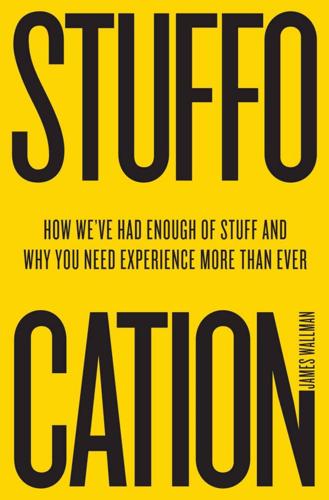
Stuffocation
by
James Wallman
Published 6 Dec 2013
Using the Present to Forecast the Future For an excellent introduction to forecasting, read the first chapter of Martin Raymond, The Trend Forecaster’s Handbook (London: Lawrence King, 2010). I have Martin Raymond to thank for introducing me to the field of forecasting, and teaching me a great deal of what I know about it. For good examples of forecasting from the past, take a look at two prescient texts: Alvin Toffler, Future Shock (New York: Random House, 1970), and Daniel Bell, The Coming of Post-Industrial Society (New York: Basic Books, 1973). CHAPTER TWO The Original Mad Men and the Job of Creating Desire To understand where the ideas came from that influenced the original Mad Men – people like Edward Bernays and Earnest Elmo Calkins and Christine Frederick – read Wilfred Trotter, Instincts of the Herd in Peace and War (London: Macmillan, 1916); Gustave Le Bon, The Crowd: A Study of the Popular Mind (London: Unwin, 1903); Edward Bernays, Propaganda (New York: H Liveright, 1928, IG Publishing, 2005 edition); Edward Bernays, Crystallizing Public Opinion (New York: Liveright, 1923); Stuart Ewen, Captains of Consciousness (New York: McGraw-Hill, 1976); Stuart Ewen, PR!
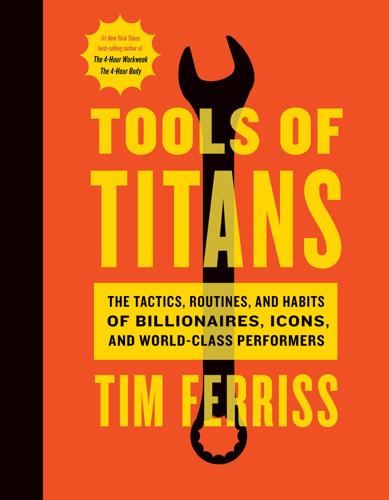
Tools of Titans: The Tactics, Routines, and Habits of Billionaires, Icons, and World-Class Performers
by
Timothy Ferriss
Published 6 Dec 2016
✸ Best recent purchase of under $100? BabyBjörn baby carrier. ✸ Do you have any quotes that you live your life by or think of often? “‘Any useful statement about the future should at first seem ridiculous’ by Jim Dator. Also, ‘When it comes to the future, it’s far more important to be imaginative than to be right’ by Alvin Toffler. Both are famous futurists. These quotes remind me that world-changing ideas will seem absurd to most people, and that the most useful work I can be doing is to push the envelope of what is considered possible. If what I’m doing sounds reasonable to most people, then I’m not working in a space that is creative and innovative enough!”
…
Feynman), Recession Proof Graduate (Charlie Hoehn), Ogilvy on Advertising (David Ogilvy), The Martian (Andy Weir) Kamkar, Samy: Influence (Robert Cialdini) Kaskade: Lights Out: A Cyberattack, A Nation Unprepared, Surviving the Aftermath (Ted Koppel) Kass, Sam: Sapiens (Yuval Noah Harari), The Art of Fielding (Chad Harbach), Plenty; Jerusalem; Plenty More (Yotam Ottolenghi), The Flavor Bible: The Essential Guide to Culinary Creativity, Based on the Wisdom of America’s Most Imaginative Chefs (Karen Page and Andrew Dornenburg), A History of World Agriculture (Marcel Mazoyer and Laurence Roudart) Kelly, Kevin: The Adventures of Johnny Bunko (Daniel Pink), So Good They Can’t Ignore You (Cal Newport), Shantaram (Gregory David Roberts), Future Shock (Alvin Toffler), Regional Advantage: Culture and Competition in Silicon Valley and Route 128 (AnnaLee Saxenian), What the Dormouse Said: How the Sixties Counterculture Shaped the Personal Computer Industry (John Markoff), The Qur’an, The Bible, The Essential Rumi; The Sound of the One Hand: 281 Zen Koans with Answers (Yoel Hoffman), It’s All Too Much: An Easy Plan for Living a Richer Life with Less Stuff (Peter Walsh) Koppelman, Brian: What Makes Sammy Run?
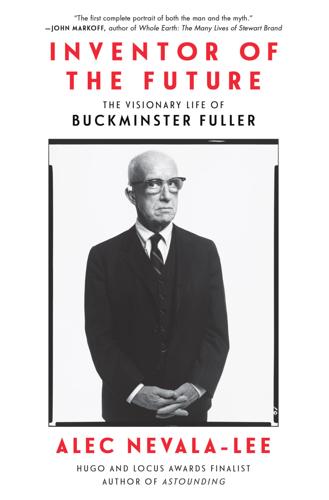
Inventor of the Future: The Visionary Life of Buckminster Fuller
by
Alec Nevala-Lee
Published 1 Aug 2022
Despite the brush-off, Fuller agreed to work on Smith’s book, with part of the proceeds donated to Narconon, a nonprofit “dedicated to reducing crime and drug abuse, for their youth program.” In reality, it was a vehicle for Hubbard’s theories and affiliated closely with Scientology. As the futurist Alvin Toffler characterized Fuller as “the leader of something approaching a religious movement,” other groups were turning his ideas to more positive ends. Domes went up at the Libre and Red Rockers communes in Colorado; teenagers built a dome as a youth center in the Bronx; and CHARAS had been working quietly all this time on the Lower East Side.
…
“dedicated to reducing crime”: Copyright page of RBF, Buckminster Fuller to Children of Earth, comp. and photographed by Cam Smith (Garden City, NY: Doubleday, 1972). a vehicle for Hubbard’s theories: Lawrence Wright, Going Clear: Scientology, Hollywood, and the Prison of Belief (New York: Vintage Books, 2013), 241–43. “the leader of something”: Alvin Toffler, The Futurists (New York: Random House, 1972), 6. Libre and Red Rockers: Amy Azzarito, “Libre, Colorado, and the Hand-Built Home,” in West of Center: Art and the Counterculture Experiment in America, 1965–1977, ed. Elissa Auther and Adam Lerner (Minneapolis: University of Minnesota Press, 2012), 95–108.

The True and Only Heaven: Progress and Its Critics
by
Christopher Lasch
Published 16 Sep 1991
The British journalist Michael Wood, citing the revival of the popular music of the fifties, the commercial appeal of movies about World War II, and the saturation of the airwaves with historical dramas—"Upstairs, -116- Downstairs," "The Pallisers," "The Forsyte Saga"—declared, "The disease, if it is a disease, has suddenly become universal." The nostalgic "climate," he said, indicated a "general abdication, an actual desertion from the present." Alvin Toffler advanced a similar view in his Future Shock. The transition from industrial society to "postindustrial" society, according to Toffler, left people disoriented and confused. Unable to face the future, all too many sought refuge in the past. "Reversionists" like Barry Goldwater and George Wallace "yearned for the simple, ordered society of the small town," while the left developed its own version of the "politics of nostalgia," based on "bucolic romanticism," an "exaggerated veneration of pre-technological societies," and an "exaggerated contempt for science and technology."
…
Dudden, "Nostalgia and the American," Journal of the History of Ideas 32 (1961): 515-30; Fred Davis, "Nostalgia, Identity, and the Current Nostalgia Wave,"Journal of Popular Culture II (1977): 4I4-24; "The Great Nostalgia Kick," U.S. News & World Report, 22 March 1982, 57; -537- Gerald Clarke, "The Meaning of Nostalgia," Time, 3 May 1971, 77; Michael Wood, "Nostalgia or Never," New Society 30 (7 Nov. 1974): 343-47; Alvin Toffler, Future Shock (1970); Peter Clecak, America's Search for the Ideal Self (1983); "Nostalgia," Newsweek, 28 Dec. 1970, 34-38; Frank Heath, "Nostalgia Shock," Saturday Review, 29 May 1971, 18; "Why the Craze for the 'Good Old Days'?" U.S. News & World Report, I2 Nov. 1973, 72; Howard F. Stein, "American Nostalgia," Columbia Forum, n.s. 3 (summer 1974): 20-23; Richard Hasbany, "Irene: Considering the Nostalgic Sensibility," Journal of Popular Culture 9 (spring 1976): 816-26; Roy McMullen, "That Rose-Colored Rearview Mirror," Saturday Review, 2 Oct. 1976, 22-23; "There's Gold in That Nostalgia," Newsweek, II Oct. 1976, 49-50; "Packing Up the Past," Good Housekeeping, Nov. 1979, 94ff.; Robert Rubens, "The Backward Glance: A Contemporary Taste for Nostalgia," Contemporary Review (London) 239 (Sept.
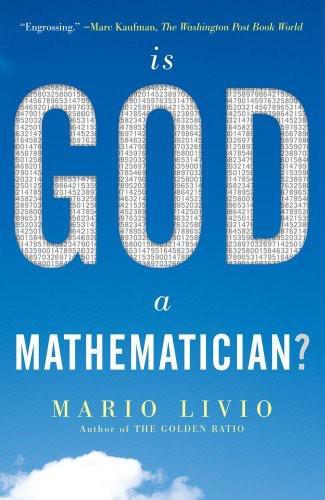
Is God a Mathematician?
by
Mario Livio
Published 6 Jan 2009
Berkeley certainly had a point, and the fact is that a fully consistent theory of analysis was only formulated in the 1960s. But mathematics was about to experience a more dramatic crisis in the nineteenth century. CHAPTER 6 GEOMETERS: FUTURE SHOCK In his famous book Future Shock, author Alvin Toffler defined the term in the title as “the shattering stress and disorientation that we induce in individuals by subjecting them to too much change in too short a time.” In the nineteenth century, mathematicians, scientists, and philosophers experienced precisely such a shock. In fact, the millennia-old belief that mathematics offers eternal and immutable truths was crushed.
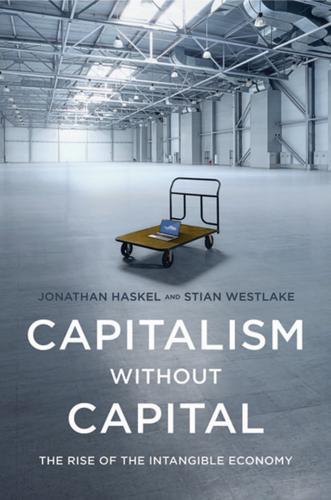
Capitalism Without Capital: The Rise of the Intangible Economy
by
Jonathan Haskel
and
Stian Westlake
Published 7 Nov 2017
All these things had taken time and money to build up and had a lasting value to whoever owned the airport, but they consisted not of physical stuff but of ideas, knowledge, and social relations. In the language of economists, they were intangible. The idea that an economy might come to depend on things that were immaterial was an old one. Futurists like Alvin Toffler and Daniel Bell had begun to talk about the “post-industrial” future as long ago as the 1960s and 1970s. As the power of computers and the Internet became more apparent in the 1990s, the idea that immaterial things were economically important became increasingly widely accepted. Sociologists talked of a “network society” and a “post-Fordist” economy.

Virtual Light
by
William Gibson
Published 1 Jan 1993
It conceives of the world, in other words, in postmodern terms. According to Gibson's geography, cultural identities have become neutralized. The international and intercultural have become the norm. He suggests it is thus grossly naive to think of oneself as an intellectual within any national restriction. This rhymes with Alvin Toffler's assertions in his futurist sociological study, The Third Wave (1980), which cyberpunk spokesperson Bruce Sterling calls "a bible to many cyberpunks."(14) Toffler argues that, as we approach a new millennium, globalism has become an "evolutionary necessity" for our planet, and that it will be suicidal for us to pretend otherwise.(15) If Gibson's imagination is deeply international, it is also deeply intertextual.

Squeezed: Why Our Families Can't Afford America
by
Alissa Quart
Published 25 Jun 2018
Leary, “Scholarly reflections on the ‘Selfie,’” OUPblog, November 19, 2013, https://blog.oup.com/2013/11/scholarly-reflections-on-the-selfie-woty-2013/. Leary was asked, along with several other scholars, to write a short reflection; the article is not attributed to him. “people can convey”: “Prosumption,” originally coined by Alvin Toffler, combines production and consumption in the same action. We offer ourselves on social media, to our friends, glamorized and sanitized. Somewhere therein is a hope that these images will raise our general social capital and will cover over, say, our downsized journalism or legal careers. the wealthy of television past: If we go even further back, before television ever flickered into view, the films of one of the worst economic times in our history, the Depression, were famous for their opulence.
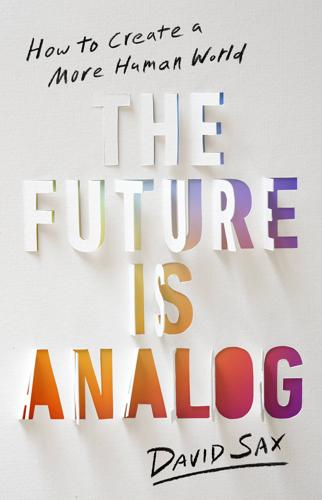
The Future Is Analog: How to Create a More Human World
by
David Sax
Published 15 Jan 2022
In 1969, a scientist at the US Patent Office named Allan Kiron predicted that computers and new communications tools would change the nature of work and bring it home. He coined the term dominetics, an awkward portmanteau of domicile, connections, and electronics that failed to catch on but inspired others, such as academic Jack Nilles’s telecommuting, which pitched working from home as a solution to long drives. As the PC era dawned in 1980, futurist Alvin Toffler predicted that home would soon become an “electronic cottage,” where internet-enabled home offices would bring us greater flexibility with both work and family, while downtown offices would be “reduced to use as ghostly warehouses or converted into living space.” As digital technology grew more powerful, inexpensive, and common in every profession, remote work became a reality for many.

Digital Dead End: Fighting for Social Justice in the Information Age
by
Virginia Eubanks
Published 1 Feb 2011
Flatter hierarchies and more interesting work are the social payoffs; rising incomes and an end to slumps the economic payoffs. Quality replaces quantity, knowledge replaces physical capital, and flexible networks replace rigid organization charts” (Henwood 2003, 3–4). 14. Among the most popular are Daniel Bell’s The Coming of Post-Industrial Society (1976), Alvin Toffler’s The Third Wave (1980), John Naisbett’s Megatrends (1984), Peter Drucker’s Post-Capitalist Society (1993), Bill Gates’s The Road Ahead (1996), Kevin Kelly’s Out of Control (1995) and New Rules for the New Economy (1998), Esther Dyson’s Release 2.0 (1997), Thomas Friedman’s The World Is Flat (2005), and Don Tapscott’s Wikinomics (2006). 15.

Brexit, No Exit: Why in the End Britain Won't Leave Europe
by
Denis MacShane
Published 14 Jul 2017
. […] In this bewildering context, businessmen swim against highly erratic economic currents; politicians see their ratings bob up and down […] value systems splinter and crash’ as the world lived with ‘the deepest social upheaval and creative restructuring of all time.’ This over-excited hyperbole was from the best-selling book The Third Wave by the futurologist Alvin Toffler, written four decades ago. Today there are plenty of commentators and writers to tell us that we are living in equally challenging and fast-changing times. Just so, but by any definition Europeans, even with all their problems, live a far better life than they did in 1980 and intelligent political choices can help.

#Republic: Divided Democracy in the Age of Social Media
by
Cass R. Sunstein
Published 7 Mar 2017
Putnam, Bowling Alone: The Collapse and Revival of American Community (New York: Simon and Schuster, 2000), 221, 229. 3.Elizabeth Dwoskin, “Pandora Thinks It Knows If You Are a Republican,” Wall Street Journal, February 13, 2014, http://www.wsj.com/articles/SB10001424052702304315004579381393567130078 (accessed August 31, 2016). 4.Quoting Alvin Toffler in Sikes, Fast Forward, 208. 5.Hague v. Committee for Industrial Organization, 307 U.S. 496 (1939). For present purposes, it is not necessary to discuss the public forum doctrine in detail. Interested readers might consult Geoffrey R. Stone, Robert H. Seidman, Cass R. Sunstein, Mark Tushnet, and Pamela Karlan, The First Amendment, 4th ed.
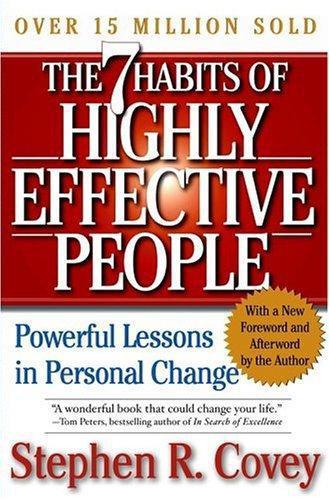
The 7 Habits of Highly Effective People: Powerful Lessons in Personal Change
by
Stephen R. Covey
Published 9 Nov 2004
That phrase represents the evolution of three generations of time management theory, and how to best do it is the focus of a wide variety of approaches and materials. Personal management has evolved in a pattern similar to many other areas of human endeavor. Major developmental thrusts, or "waves" as Alvin Toffler calls them, follow each other in succession, each adding a vital new dimension, For example, in social development, the agricultural revolution was followed by the industrial revolution, which was followed by the informational revolution. Each succeeding wave created a surge of social and personal progress.

An Optimist's Tour of the Future
by
Mark Stevenson
Published 4 Dec 2010
It’s not because I think any of these innovations are a bad idea; it’s because quite simply I don’t feel ready. It all seems to be coming too fast. I’m almost expecting that by the time I walk out of John’s office I’ll find the world already transformed into some futuristic society that I’ve no idea how to operate in. Perhaps I have the first mild onset of a phenomenon identified by sociologist Alvin Toffler – ‘future shock’ – which can be summarised as too much changing too quickly for you to get your head around. Part of the re-boot, then, is finding a way to deal with change as the norm and not the exception, realizing that society, having enjoyed a period of relative stability since the Industrial Revolution is, in my lifetime, going to see a radical shift.
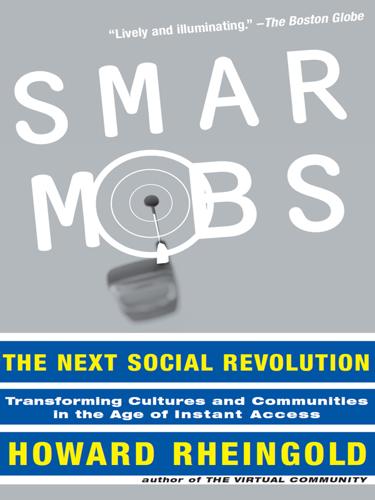
Smart Mobs: The Next Social Revolution
by
Howard Rheingold
Published 24 Dec 2011
Jeremy Lovell, “Briton Wires Nervous System to a Computer,” Reuters, 22 March 2002, <http://story.news.yahoo.com/news?tmpl=story&cid=581&u=/nm/20020322/tc_nm/britain_cybernetics_dc_2 > (27 March 2002). 53. Marshall Berman, All That Is Solid Melts into Air: The Experience of Modernity (New York: Penguin Books, 1982). 54. Alvin Toffler, The Third Wave (New York: William Morrow, 1980). 55. Lawrence Lessig, The Future of Ideas: The Fate of the Commons in aConnected World (New York: Random House, 2001). 56. C. M. Kornbluth, “The Marching Morons,” Galaxy, April 1951. 57. Sean Griffin, “Walt Disney Programs,” <http://www.museum.tv/archives/etv/W/htmlW/waltdisneyp/waltdisneyp.htm >. 58.

Frenemies: The Epic Disruption of the Ad Business
by
Ken Auletta
Published 4 Jun 2018
Unilever, Procter & Gamble, Coca-Cola, L’Oréal, Kraft Foods, Mondelēz International, Bank of America, General Mills, Sony, 21st Century Fox, Johnson & Johnson, and CVS were just some of the advertisers who put their agency business up for review. Mandel’s kickbacks speech was a spur for the reviews, but it was hardly the only one. Indeed, its timing was exquisitely awful because advertisers were already being buffeted by change, facing disruptive forces in practically every sector of their business. As Alvin Toffler wrote in Future Shock, any industry bombarded by menacing changes endures “the dizzying disorientation brought on by the premature arrival of the future.” MediaLink brands itself as a neutral Switzerland, positioned comfortably in the middle, which is an odd definition of neutrality since MediaLink often represents all sides at a negotiating table.

Flying Blind: The 737 MAX Tragedy and the Fall of Boeing
by
Peter Robison
Published 29 Nov 2021
John, James’s son and Sandy’s successor, tried to connect with employees, but he came off as patronizing. He recorded videotapes quarterly and sent them to the company’s 113,000 employees, or “teammates,” as Mr. Mac had always preferred to call them. The bearded, bespectacled Princeton graduate would offer advice about responding to change, quoting from books like Alvin Toffler’s Future Shock. He cautioned his charges to avoid “petty competition, jealousy, and fear of losing turf.” In one of the videotapes he told a story about a gardener he’d spotted on the grounds of the St. Louis campus using a rake that was missing most of its tines: “Obviously, this person was not being very productive,” he sniffed.

Cryptoassets: The Innovative Investor's Guide to Bitcoin and Beyond: The Innovative Investor's Guide to Bitcoin and Beyond
by
Chris Burniske
and
Jack Tatar
Published 19 Oct 2017
Star Trek featured several that proved to be not so outlandish: the indispensable handheld communicators have become today’s smartphones, the personal access display device is now our tablet, and a universal translator exists, of which there are several apps to choose. Edward Bellamy’s enigmatically titled 1887 book Looking Backward predicted debit and credit cards, and 2001: A Space Odyssey imagined forms of social media, though nothing on the scale that we currently have. Alvin Toffler’s Future Shock gripped readers in the 1970s as it predicted the exponential change destined to shake our society, and issued a warning: “In the three short decades between now and the twenty-first century, millions of ordinary, psychologically normal people will face an abrupt collision with the future.”

Superminds: The Surprising Power of People and Computers Thinking Together
by
Thomas W. Malone
Published 14 May 2018
Zuckerman, “The Problems and Promise of Hierarchy: Voice Rights and the Firm” (unpublished manuscript, November 11, 2014), https://ssrn.com/abstract=2523245. 4. Thomas W. Malone, The Future of Work: How the New Order of Business Will Shape Your Organization, Your Management Style, and Your Life (Boston, MA: Harvard Business School Press, 2004). 5. Alvin Toffler, Future Shock (New York: Random House, 1970); Warren Bennis, The Temporary Society (New York: Harper & Row, 1968); Henry Mintzberg, The Structuring of Organizations: A Synthesis of the Research (Englewood Cliffs, NJ: Prentice Hall, 1979). 6. Valve Corporation, Valve: Handbook for New Employees (Bellevue, WA: Valve Corporation, 2012).
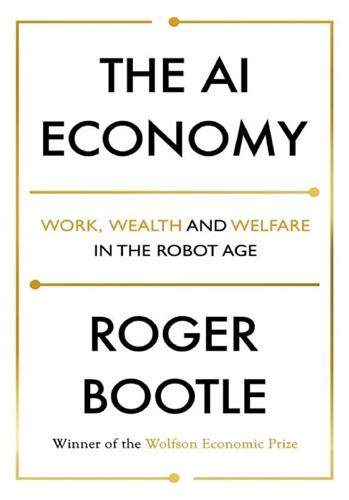
The AI Economy: Work, Wealth and Welfare in the Robot Age
by
Roger Bootle
Published 4 Sep 2019
In fact, we have not been in such a world for quite a while yet the relationship between work and education has trundled on as though nothing had changed. The AI economy promises to be much less like what we have grown up with. The implication is that people will need to have several periods of learning and training in their life, interspersed with periods of employment.28 The great thinker and futurist Alvin Toffler long ago suggested that “the illiterate of the twenty-first century will not be those who cannot read and write, but those who cannot learn, unlearn, and relearn.”29 This implies that the labor force must be able to change as rapidly as the environment around them is changing. This can apply as much to “education for leisure.”
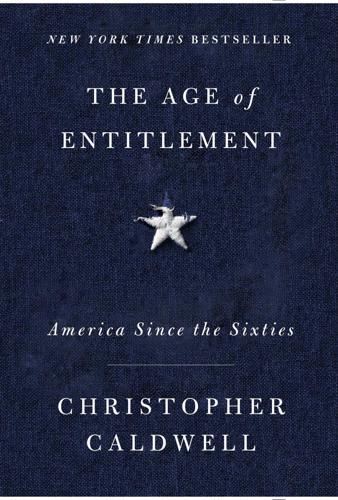
The Age of Entitlement: America Since the Sixties
by
Christopher Caldwell
Published 21 Jan 2020
Long before the average American had any experience of computers, they were the stuff of dystopic science fiction movies and “This does not compute!” jokes on Saturday-morning cartoons. Until well into the Reagan era, typefaces like Gemini (1965), Amelia (1967), Computer (1968), Data 70 (1970), and Orbit-B (1972) imparted a “Space Age” look to books of technological prediction, Alvin Toffler’s Future Shock (1970), for instance. Those fonts were all patterned on E13B, designed by engineers at Stanford and General Electric in the mid-1950s for magnetic-ink check-reading machines. That an Eisenhower-era innovation looked like “futuristic” technology for three decades was a sign of complacency.
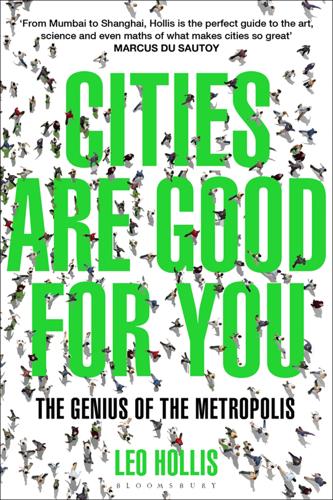
Cities Are Good for You: The Genius of the Metropolis
by
Leo Hollis
Published 31 Mar 2013
Under the Movirtu scheme, communities can share a phone; however, each person is to be given a unique number to make and receive individual calls. Therefore a community can come together to purchase a phone yet with a guarantee of privacy for each individual. It has often been suggested that the latest technology threatens the city. For the bestselling futurologist Alvin Toffler technology allows one to be connected anywhere in the world and thus we will all live and work remotely in ‘electronic cottages’, far from the city limits. Why tolerate the problems of the city when we no longer have to live on top of one another? But strangely enough, thanks to new technology – mobiles, the internet, Web 2.0 – we are now more and more likely to embrace the complex density of the city than ever before.

The Long Boom: A Vision for the Coming Age of Prosperity
by
Peter Schwartz
,
Peter Leyden
and
Joel Hyatt
Published 18 Oct 2000
Things That Make Us Smart, Defending Human Attributes in the Age of the Machine, by Donald A. Norman (Reading, MA: Addison-Wesley, 1993). Norman has crusaded for designing our technologies to more seamlessly integrate into our world and, in doing so, has helped envision a future of ubiquitous computing. 320 Selected BiblioejRApky The Third Wave, the Classic Study of Tomorrow, by Alvin Toffler (New York: Bantam Books, 1980). So far ahead of its time in describing elements of the shift to the global networked society that it's still relevant. The Unbound Prometheus, by David S. Landes (New York: Cambridge University Press, 1969). Shows the power of technology as a key driving force in long-term economic change, with a particular focus on the industrial revolution.
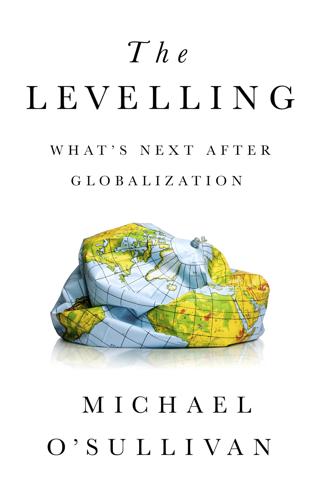
The Levelling: What’s Next After Globalization
by
Michael O’sullivan
Published 28 May 2019
There is another element that may help unite the notion of the rise and fall of countries and their enduring successes: the extent to which countries move in developmental, economic, and demographic cycles. Several books have explored these themes: for example, Walt Rostow’s The Stages of Economic Growth, Alvin Toffler’s The Third Wave, and William Strauss and Neil Howe’s The Fourth Turning. One of the places where the rise and fall of nations is visible is in financial markets. Looking at long-term changes in stock market capitalization is one way of examining this. For example, in 1900 the proportion of the world stock market made up by the US market was 15 percent, Germany held 13 percent, Japan held close to none, and the United Kingdom held 25 percent.

Before the Storm: Barry Goldwater and the Unmaking of the American Consensus
by
Rick Perlstein
Published 17 Mar 2009
It featured an interview with Peggy Goldwater. She described how, when working eighteen-hour days opening a new store in Prescott in 1937, her husband’s “nerves broke completely.” The problem abated, she said, then resurfaced two years later, never to come back again. It was the interviewer, a journalist named Alvin Toffler, who chose to describe these incidents with the fateful words “nervous breakdown.” Muckraking liberal columnist and radio commentator Drew Pearson picked up the story and started the drumbeat: Goldwater wasn’t mentally fit to be Commander in Chief. If Nelson Rockefeller had been a candidate of more ordinary means, he might have begun to question the expense of maintaining an elaborate opposition research operation to impugn a campaign so skilled at delivering knockout blows against itself.
…
For BOMFOG, see Rowland Evans and Robert Novak, SEP, May 30, 1964. 339 For Spencer-Roberts drumming up crowds, see Time, June 12, 1964. For appeal to blacks, see NAR to Fresno Elks, March 13, 1964, RAC, Box 11/940. For Berkeley, see San Francisco Examiner, March 13, 1964. 339 For attempt to break story of Goldwater’s psychological episodes, I rely on Molitor interview. Peggy Goldwater interview is in Alvin Toffler, “The Woman Behind Barry Goldwater,” Good Housekeeping, May 1964. See Time, June 12, 1964, for Drew Pearson. 339 For Goldwater paraphernalia generally, see Summer 1982 special issue of The Keynoter, “A Choice, Not an Echo: The 1964 Campaign of Barry Goldwater.” For “Arriba con Barry,” see Kitchel to Woodruff, April 13, 1964, AHF, Box 13/42.

Microtrends: The Small Forces Behind Tomorrow's Big Changes
by
Mark Penn
and
E. Kinney Zalesne
Published 5 Sep 2007
Hidden right in front of us are powerful counterintuitive trends that can be used to drive a new business, run a campaign, start a movement, or guide your investment strategy. Even though these trends are staring us in the face, we often don’t really see them. Trend Spotters in Context I am part of a proud line of trend-spotters. Alvin Toffler, who wrote the Future Shock series, and John Naisbitt, who wrote Megatrends, were some of the first thinkers in the modern era to look at the huge, changing world of human behavior and try to make some sense of it with facts and data. They got it right that the Information Age would change everything.
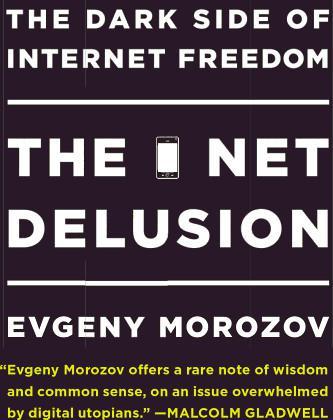
The Net Delusion: The Dark Side of Internet Freedom
by
Evgeny Morozov
Published 16 Nov 2010
Anyone following the zeitgeist of the late 1980s and early 1990s couldn’t have missed the connection between two popular theories at the time, one pertaining to technology and one to politics, that, in a rather mysterious twist, bore virtually the same name. One theory, developed by the futurist Alvin Toffler, posited that the rapid technological change of the period would give rise to the “Third Wave Society,” marked by democratized access to knowledge and the dawn of the information age. For Toffler, information technology followed two other revolutionary waves, agriculture and industrialization, ushering in a completely new period in human history.

The Personal MBA: A World-Class Business Education in a Single Volume
by
Josh Kaufman
Published 2 Feb 2011
Use all four options when processing your to-do list, and you’ll get more done than you ever thought possible. SHARE THIS CONCEPT: http://book.personalmba.com/4-methods-of-completion/ Most Important Tasks (MITs) You’ve got to think about the big things while you’re doing small things, so that all the small things go in the right direction. —ALVIN TOFFLER, TECHNOLOGY RESEARCHER AND FUTURIST Not all tasks are created equal—some are more important than others. You only have so much time and energy to get things done each day. Of all of the things that are on your to-do list right now, some of them are really important, and some of them really aren’t important.

Blockchain Revolution: How the Technology Behind Bitcoin Is Changing Money, Business, and the World
by
Don Tapscott
and
Alex Tapscott
Published 9 May 2016
Interview with Yochai Benkler, August 26, 2015. 32. www.nytimes.com/2013/07/21/opinion/sunday/friedman-welcome-to-the-sharing-economy.html?pagewanted=1&_r=2&partner=rss&emc=rss&. 33. Sarah Kessler, “The Sharing Economy Is Dead and We Killed It,” Fast Company, September 14, 2015; www.fastcompany.com/3050775/the-sharing-economy-is-dead-and-we-killed-it#1. 34. “Prosumers” is a term invented by Alvin Toffler in Future Shock (1980). In The Digital Economy (1994) Don Tapscott developed the concept and notion of “prosumption.” 35. Interview with Robin Chase, September 2, 2015. 36. https://news.ycombinator.com/item?id=9437095. 37. This scenario was originally explained by Don Tapscott in “The Transparent Burger,” Wired, March 2004; http://archive.wired.com/wired/archive/12.03/start.html?

In Spite of the Gods: The Rise of Modern India
by
Edward Luce
Published 23 Aug 2006
Quoted in India Today, the weekly newsmagazine, August 8, 2005, p. 49. 24. The poll of 15,000 people nationwide was conducted in 2005 by the Centre for the Study of Developing Societies for IBN-CNN news channel. CHAPTER 4 1. Quoted in Amartya Sen, The Argumentative Indian, p. 159. 2. Dr. Tupkary said some of the terms and ideas had been borrowed from Alvin Toffler, the American futurologist, whose books The Third Wave and Future Shock were widely read in the 1970s and 1980s. 3. Readers interested in the Harappans have much from which to choose. They could start with Romila Thapar’s Early India, A. Ghosh’s The City in Early Historical India, F. Braudel, A History of Early Civilisations, or A.
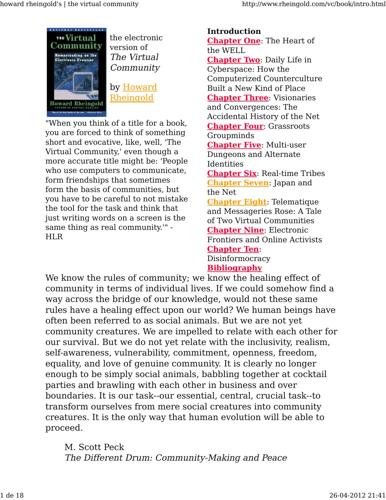
Howard Rheingold
by
The Virtual Community Homesteading on the Electronic Frontier-Perseus Books (1993)
Published 26 Apr 2012
In the private sector, telecommunication companies, television networks, computer companies, cable companies, and newspapers 26-04-2012 21:41 howard rheingold's | the virtual community 13 de 18 http://www.rheingold.com/vc/book/intro.html in the United States, Europe, and Japan are jockeying for position in the nascent "home interactive information services industry." Corporations are investing hundreds of millions of dollars in the infrastructure for new media they hope will make them billions of dollars. Every flavor of technological futurist, from Alvin Toffler and John Naisbitt to Peter Drucker and George Gilder, base utopian hopes on "the information age" as a techno-fix for social problems. Yet little is known about the impact these newest media might have on our daily lives, our minds, our families, even the future of democracy. CMC has the potential to change our lives on three different, but strongly interinfluential, levels.
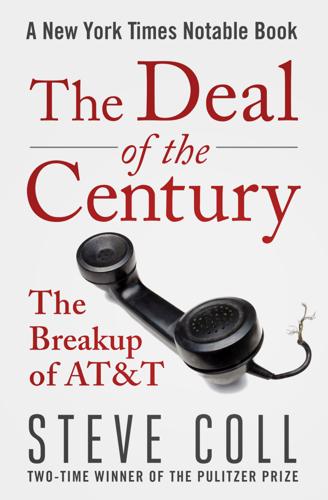
The Deal of the Century: The Breakup of AT&T
by
Steve Coll
Published 12 Jun 2017
But Charlie Brown’s entrancing vision of an unbridled AT&T racing into the technology-driven “information age,” competing with the likes of IBM and Wang and Data General and others for dominance of the “global information village” imagined by popular academic futurists such as Marshall McLuhan, John Naisbitt, and Alvin Toffler, has already been clouded by muddled realities, and there is much evidence that his company’s boundaries will continue to shrink, rather than grow, in the decades ahead. McGowan and MCI, on the other hand, lacking any guarantee of long-term profitability, once again face the possibility of financial difficulty, and while the vista is familiar to McGowan, this time there will be nothing to grab onto if he falls.

Twitter and Tear Gas: The Power and Fragility of Networked Protest
by
Zeynep Tufekci
Published 14 May 2017
Lowe, “For Want of a Nail,” Analysis 40, no. 1 (1980): 50–52. 2. The term “adhocracy” comes from a very different context: management strategy. The term originated with the management scholars Warren G. Bennis and Philip E. Slater (The Temporary Society [New York: Harper and Row, 1964]) and was adopted by futurists Alvin and Heidi Toffler (Alvin Toffler, Future Shock [New York: Bantam Books, 1970]). It was touted as a management strategy in the 1980s. (For example, see Robert H. Waterman, Adhocracy: The Power to Change [New York: W. W. Norton, 1993].) For a history of the term, see Timothy E. Dolan, “Revisiting Adhocracy: From Rhetorical Revisionism to Smart Mobs,” Journal of Futures Studies 15, no. 2 (2010): 33–50, http://www.jfs.tku.edu.tw/15-2/A03.pdf.

Jihad vs. McWorld: Terrorism's Challenge to Democracy
by
Benjamin Barber
Published 20 Apr 2010
The old Baconian dictum that knowledge is power and that through science we can command the world, the belief that the improvement of men’s minds and the improvement of his lot are finally the very same thing, was at the heart of the Enlightenment’s conviction that reason embodied in science and technology could liberate the human race from prejudice, ignorance, and injustice—could eventually liberate all women and men and democratize their social institutions. Walter B. Wriston is only the latest of a host of Enlightenment-infused panglossian futurologists from Condorcet to Alvin Toffler who have composed odes to the emancipatory, democratic powers of the startling new technologies that drive McWorld and have transformed capitalism from a system that serves needs into a system that creates and manipulates them. In The Twilight of Sovereignty, Wriston calls his final chapter “Power to the People.”
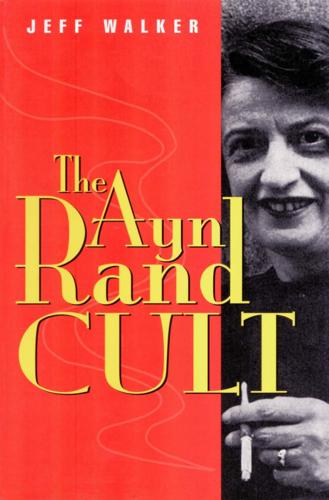
Ayn Rand Cult
by
Jeff Walker
Published 30 Dec 1998
. ———. Atlas Shrugged. New York: Random House, 1957. ———. Anthem. New York: Signet, 1961 [Caldwell, Idaho: Caxton, 1946]. ———. For the New Intellectual. New York: Random House, 1961. ———. The New Left: The Anti-Industrial Revolution. Revised 2nd edn. New York: Signet, 1963. ———. Interviewed by Alvin Toffler. Playboy (March 1964). ———. The Romantic Manifesto. Revised 2nd edn. New York: Signet, 1971 [Cleveland: World Publishing, 1969]. ———. The Foreign Policy of a Mixed Economy. 1965 talk. Audiotape. New Milford: Second Renaissance. ———. Speaking Freely: Ayn Rand Interviewed. Edwin Newman, interviewer.

Physics of the Future: How Science Will Shape Human Destiny and Our Daily Lives by the Year 2100
by
Michio Kaku
Published 15 Mar 2011
Michael Salamon, NASA’s Beyond Einstein program Adam Savage, host of MythBusters Peter Schwartz, futurist, cofounder of Global Business Network, author of The Long View Michael Shermer, founder of the Skeptics Society and Skeptic magazine Donna Shirley, former manager, NASA Mars Exploration Program Seth Shostak, SETI Institute Neil Shubin, professor of organismal biology and anatomy, University of Chicago, author of Your Inner Fish Paul Shuch, executive director emeritus, SETI League Peter Singer, author of Wired for War, Brookings Institute Simon Singh, author of Big Bang Gary Small, coauthor of iBrain Paul Spudis, Planetary Geology Program of the NASA Office of Space Science, Solar System Division Steven Squyres, professor of astronomy, Cornell University Paul Steinhardt, professor of physics, Princeton University, coauthor of Endless Universe Gregory Stock, UCLA, author of Redesigning Humans Richard Stone, The Last Great Impact on Earth, Discover Magazine Brian Sullivan, formerly with the Hayden Planetarium Leonard Susskind, professor of physics, Stanford University Daniel Tammet, autistic savant, author of Born on a Blue Day Geoffrey Taylor, physicist, University of Melbourne the late Ted Taylor, designer of U.S. nuclear warheads Max Tegmark, physicist, MIT Alvin Toffler, author of The Third Wave Patrick Tucker, World Future Society Admiral Stansfield M. Turner, former Director of Central Intelligence Chris Turney, University of Exeter, UK, author of Ice, Mud and Blood Neil deGrasse Tyson, director, Hayden Planetarium Sesh Velamoor, Foundation for the Future Robert Wallace, coauthor of Spycraft, former director of CIA’s Office of Technical Services Kevin Warwick, human cyborgs, University of Reading, UK Fred Watson, astronomer, author of Stargazer the late Mark Weiser, Xerox PARC Alan Weisman, author of The World Without Us Daniel Werthimer, SETI at Home, University of California at Berkeley Mike Wessler, former scientist, MIT AI Lab Arthur Wiggins, author of The Joy of Physics Anthony Wynshaw-Boris, National Institutes of Health Carl Zimmer, science writer, author of Evolution Robert Zimmerman, author of Leaving Earth Robert Zubrin, founder, Mars Society Empires of the future will be empires of the mind.
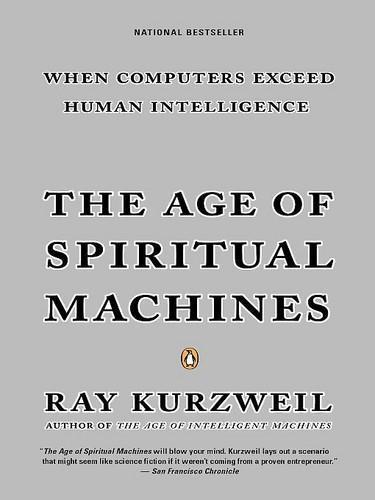
The Age of Spiritual Machines: When Computers Exceed Human Intelligence
by
Ray Kurzweil
Published 31 Dec 1998
—John von Neumann, 1949 “There’s no reason for individuals to have a computer in their home.” —Ken Olson, 1977 “640,000 bytes of memory ought to be enough for anybody.” —Bill Gates, 1981 “Long before the year 2000, the entire antiquated structure of college degrees, majors and credits will be a shambles.” —Alvin Toffler “The Internet will catastrophically collapse in 1996.” —Robert Metcalfe (inventor of Ethernet), who, in 1997, ate his words (literally) in front of an audience Now I get to toot my own horn, and can share with you those predictions of mine that worked out particularly well. But in looking back at the many predictions I’ve made over the past twenty years, I will say that I haven’t found any that I find particularly embarrassing (except, maybe, for a few early business plans).

The Best Business Writing 2013
by
Dean Starkman
Published 1 Jan 2013
Khanna and his wife fashion themselves as successors to Alvin and Heidi Toffler, an earlier fast-talking tech-addled couple who thrived on selling cookie-cutter visions of the future one paperback, slogan, and consulting gig at a time. Today the Tofflers are best-known for inspiring some of Newt Gingrich’s most outlandish ideas as well as for popularizing the term “information overload”—a phenomenon which, as numerous scholars have shown, was hardly specific to 1970 (which is when Alvin Toffler mentioned it in Future Shock) and is probably as old as books themselves. To embrace the Tofflers as intellectual role models is to make a damning admission: that one is far more interested in inventing half-clever buzzwords than in trying to understand the messy reality that those buzzwords purport to describe.
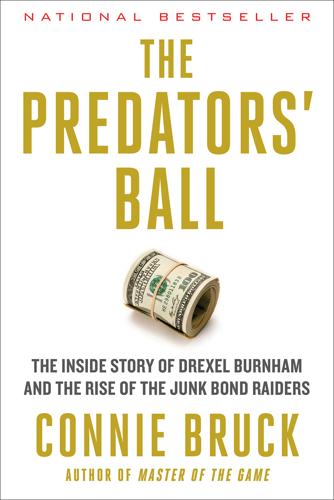
The Predators' Ball: The Inside Story of Drexel Burnham and the Rise of the JunkBond Raiders
by
Connie Bruck
Published 1 Jun 1989
Christian Andersen, who had lived through what he refers to as the “Bataan death march” on Wall Street in the early seventies, when he bounced from one failing firm to another, declared that he once had thought of getting his doctorate and teaching history; but now, in 1986, he said he felt he was making history. “We are the gentlemen who finance and create change,” Andersen declared. “When I read [Alvin] Toffler’s Future Shock, and he described this vortex of change that whirls around us, and it happens very fast in New York City, and slower in Des Moines, and even slower in the outback of Australia, the thing that was amazing to me was, when I looked at the funnel of that maelstrom, the vortex of that sits right in the middle of my desk.
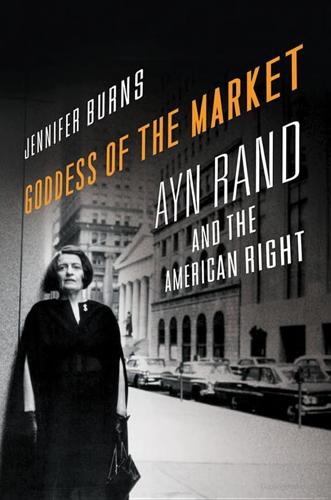
Goddess of the Market: Ayn Rand and the American Right
by
Jennifer Burns
Published 18 Oct 2009
In 1964 she reached what was then a lofty summit of journalism, the Playboy interview. In the mid-1960s Playboy was at the height of its cultural influence, publishing serious essays and commentary alongside photos of its famous playmates. Hugh Hefner had long been a fan of Rand, and his magazine ran a long and probing piece by the future futurist Alvin Toffler, who treated Rand with care and respect. She even visited a Playboy Club, which she pronounced “a wonderful place and a brilliant undertaking.” 17 Despite all the attention she attracted Rand was an unwilling celebrity. Even NBI events disconcerted her. She normally made a dramatic entrance from the back of the room, receiving applause as she made her way to the stage.

Track Changes
by
Matthew G. Kirschenbaum
Published 1 May 2016
When Peter Straub made out the check for his IBM Displaywriter, he remembers, “What excited me in the first place was the concept of being able to write on something like a television screen. I found that idea immensely appealing. I couldn’t exactly tell you why. It certainly smacked of the future.”7 Word processing on a personal computer must have seemed like future shock incarnate to any number of writers, Alvin Toffler’s widely read prognostications arriving humming, glowing, blinking on their desks in front of them. In this chapter we will look back to some of the first researchers and writers—working in close proximity to one another—who were in a position to glimpse that future, just beneath the surface of the glass.
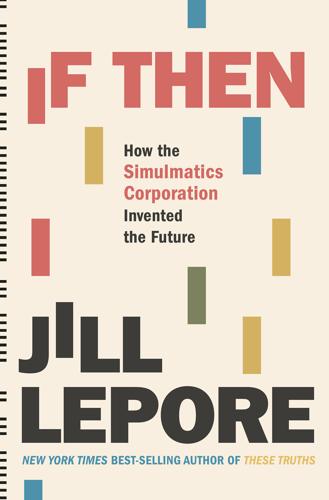
If Then: How Simulmatics Corporation Invented the Future
by
Jill Lepore
Published 14 Sep 2020
Etheredge (New Brunswick, NJ: Transaction Publishers, 2000), 301–16. Stewart Brand, The Media Lab: Inventing the Future at M.I.T. (New York: Viking, 1987), 18, 44, 214–19, 253, 267. Ibid., 33. Ibid., 183–84, 222–32. Stewart Brand, “We Owe It All to the Hippies,” Time, March 1, 1995. Esther Dyson, George Gilder, George Keyworth, and Alvin Toffler, Cyberspace and the American Dream: A Magna Carta for the Knowledge Age (Progress and Freedom Foundation, 1994). John Perry Barlow, “A Declaration of the Independence of Cyberspace,” February 8, 1996. IP, Questionnaire, undated, Pool Papers, Box 59, Folder “Contact Nets Diary.” John McPhee, “Link with Local History Lost,” Alamogordo [NM] Daily News, April 10, 1998.
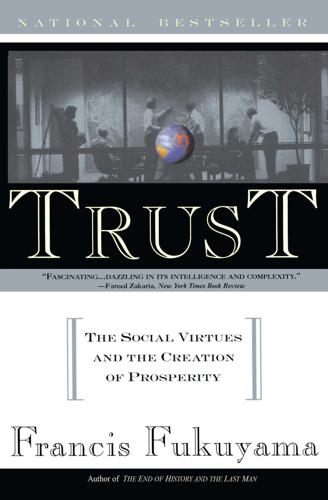
Trust: The Social Virtue and the Creation of Prosperity
by
Francis Fukuyama
Published 1 Jan 1995
Arrow, “Risk Perception in Psychology and Economics,” Economic Inquiry 20 (1982): 1-9. 19Hence, for example, we decide to buy a brand name like Kellogg’s Corn Flakes rather than the store brand because we assume, in the absence of detailed research, that it is of higher quality. 20See Becker (1976), p. 11. 21Mark Granovetter, “Economic Action and Social Structure: The Problem of Embeddedness” American Journal of Sociology 91 (1985): 481-510. 22See World Bank, The East Asian Miracle (Oxford: Oxford University Press, 1993), pp. 304-316. CHAPTER 3. SCALE AND TRUST 1See, for example, Alvin Toffler and Heidi Toffler, War and Anti-War: Survival at the Dawn of the 21st Century (Boston: Little, Brown, 1993); Peter W. Huber, Orwell’s Revenge: The 1984 Palimpsest (New York: Free Press, 1994). 2Scott Shane, Dismantling Utopia: How Information Ended the Soviet Union (Chicago: Ivan Dee, 1994); Gladys D.

Strange Rebels: 1979 and the Birth of the 21st Century
by
Christian Caryl
Published 30 Oct 2012
Its shelves were like the strata of an archaeological dig: each layer revealed more clues to Afghanistan’s overly eventful recent past. There were thick academic tomes on economics and sociology, in a variety of languages, brought in by the well-meaning development economists and missionary socialists of the 1960s and early 1970s. There were well-thumbed paperback best sellers—such as Alvin Tofflers portentous Future Shock, another artifact from my junior high years—in English, German, and French, left behind by the tourists and aid workers who had crowded into the country in the years when they were still welcome. There was a Communist-era propaganda pamphlet entitled CIA Agents Expose Their Crimes, published in 1984, in which captured rebels confessed to their sins against the state.

Boyd: The Fighter Pilot Who Changed the Art of War
by
Robert Coram
Published 21 Nov 2002
Boyd must have remembered the days, only a few years earlier, when he and Sprey were two of the most influential men in Washington; they could get an audience with any congressman or senator. Neither had a portfolio; neither had the clout that comes with being an elected or appointed official—yet the power of their ideas made them all the rage in Washington. Boyd was sought out by members of the national media. People like Hugh Sidey and Jim Fallows and Alvin Toffler hung out in his office. But it was all slipping away. Boyd began to talk of dying. “I want to go quickly,” he said. “I want to go like a light turning off, a big bang and I’m out. If I thought it was going to be any other way I’d call Kevorkian and say, ‘Hey, I got a job for you. Me.’” Boyd, by the sheer force of his personality, might have kept the reform movement alive.

The World's Banker: A Story of Failed States, Financial Crises, and the Wealth and Poverty of Nations
by
Sebastian Mallaby
Published 24 Apr 2006
For another, the sense that private firms were brilliantly managed was overblown: The stock market bubble that was inflating at the time created a parallel bubble in executive reputations. But in the mid-1990s, the superiority of the private sector was widely taken for granted. Newt Gingrich was citing the management theorists Peter Drucker and Alvin Toffler; Britain’s prime minister John Major was admitting that his government had spent some $500 million on management consultants; and even Princess Diana of Britain was consulting a business-motivation guru.3 Meanwhile Vice President Al Gore was busy “reinventing government,” and complaining that Americans endured “quill-pen government in the age of Word Perfect”;4 and William Bratton, who ran the New York Police Department from 1994 to 1996, was devolving power to precinct commanders and referring to New Yorkers as “clients.”
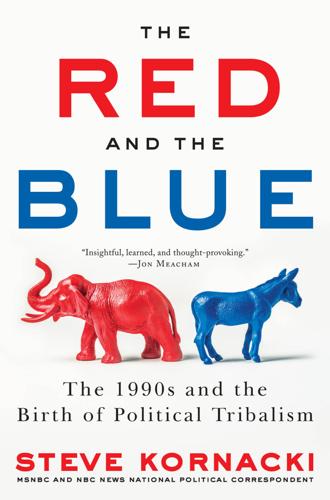
The Red and the Blue: The 1990s and the Birth of Political Tribalism
by
Steve Kornacki
Published 1 Oct 2018
And his work for Rockefeller, a liberal Republican from the Northeast, had put him in direct conflict with the party’s Goldwater-style conservatives. If anything, Gingrich’s politics were somewhere to the left of Flynt’s. The first Earth Day had been celebrated a few years earlier and he spoke approvingly of the new conservation movement. Invoking Alvin Toffler’s Future Shock, a bestselling phenomenon of the early ’70s, he talked about technology and its potential to unleash vast societal disruption. There was no question racial politics were feeding the growth of the southern Republican Party, and even indirectly, it would benefit Gingrich. But it wasn’t just the end of Jim Crow that was transforming the South.

The Technology Trap: Capital, Labor, and Power in the Age of Automation
by
Carl Benedikt Frey
Published 17 Jun 2019
The growing split between the college educated and the rest is not just one of neighborhood segregation.23 A broader shift has also taken place between cities, which is linked to the geography of new jobs. In the 1980s and 1990s, it was believed that the exact opposite would happen. With the advent of the World Wide Web, email, and cell phones, pundits proclaimed that location would soon become irrelevant and the curse of geography a distant memory.24 Futurists like Alvin Toffler even predicted that the death of distance would eventually render the city obsolete.25 And in 2005, the cover of the first edition of Thomas Friedman’s best-selling The World Is Flat pictured a world in which geographic divisions were history.26 Information technology, these authors declared, was making face-to-face interactions unnecessary, so that the time when companies and workers had to cluster in expensive places like Manhattan or Silicon Valley would soon be over.
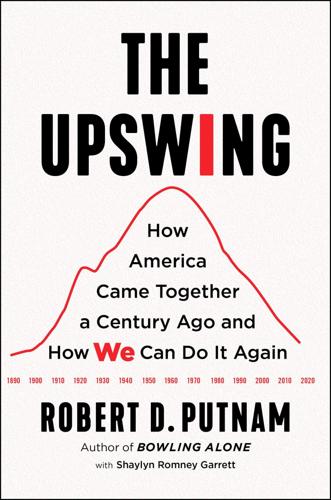
The Upswing: How America Came Together a Century Ago and How We Can Do It Again
by
Robert D. Putnam
Published 12 Oct 2020
Altruism quotation from Ayn Rand, The Virtue of Selfishness: A New Concept of Egoism (New York: Penguin, 1964), 112. 56 David Corn, “Secret Video: Romney Tells Millionaire Donors What He Really Thinks of Obama Voters,” Mother Jones, September 17, 2012, https://www.motherjones.com/politics/2012/09/secret-video-romney-private-fundraiser/. 57 Alvin Toffler, “Playboy Interview: Ayn Rand,” Playboy, March 1964, 35–43. 58 James Stewart, “As a Guru, Ayn Rand May Have Limits. Ask Travis Kalanick,” New York Times (online), July 13, 2017. https://www.nytimes.com/2017/07/13/business/ayn-rand-business-politics-uber-kalanick.html. 59 Ryan’s words come at 2:38 of a 2005 speech to the Atlas Society, “Paul Ryan and Ayn Rand’s Ideas: In the Hot Seat Again,” The Atlas Society, April 30, 2012, https://atlassociety.org/commentary/commentary-blog/4971-paul-ryan-and-ayn-rands-ideas-in-the-hot-seat-again. 60 Francis Fukuyama, The Great Disruption: Human Nature and the Reconstitution of Social Order (New York: Free Press, 1999), 13–14. 61 Herbert Marcuse, “Selection from One Dimensional Man,” in The American Intellectual Tradition, eds.
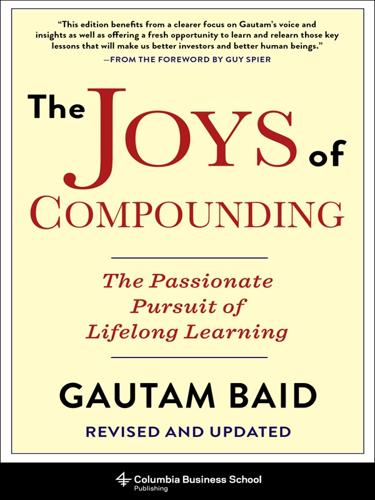
The Joys of Compounding: The Passionate Pursuit of Lifelong Learning, Revised and Updated
by
Gautam Baid
Published 1 Jun 2020
CHAPTER 27 UPDATING OUR BELIEFS IN LIGHT OF NEW EVIDENCE If anyone can refute me—show me I’m making a mistake or looking at things from the wrong perspective—I’ll gladly change. It’s the truth I’m after and the truth never harmed anyone. What harms us is to persist in self-deceit and ignorance. —Marcus Aurelius The illiterate of the 21st century will not be those who cannot read and write, but those who cannot learn, unlearn, and relearn. —Alvin Toffler It is not the strongest of the species that survive, nor the most intelligent, but the one most responsive to change. —Charles Darwin When the facts change, I change my mind. What do you do, sir? —John Maynard Keynes To others, being wrong is a source of shame; to me, recognizing my mistakes is a source of pride.

Nixonland: The Rise of a President and the Fracturing of America
by
Rick Perlstein
Published 1 Jan 2008
The Andromeda Strain, a hit in the new “disaster movie” genre, was about an apocalyptic virus brought down to earth by a fallen satellite. Dr. B. F. Skinner’s new bestseller, Beyond Freedom & Dignity—seven paperback printings in one year—asked, “If all of modern science and technology cannot significantly change man’s environment, can mankind be saved?” His solution: “We can no longer afford freedom.” Future Shock, by Alvin Toffler—seven printings in four months—said Americans were suffering a collective nervous breakdown: “In the neural system as now constituted there are, in all likelihood, inherent limits to the amount and speed of image processing that the individual can accomplish.” The public appetite for counsels of doom was bottomless.
…
“The rebirth of Israel”: Hal Lindsey, The Late Great Planet Earth (New York: Bantam, 1971). “While you are reading these words”: Paul Ehrlich, The Population Bomb (New York: Ballantine, 1971). “If all of modern science and technology”: B. F. Skinner, Beyond Freedom & Dignity (New York: Bantam, 1971). “In the neural system as now constituted”: Alvin Toffler, Future Shock (New York: Bantam, 1971). “There is a revolution coming”: Charles Reich, The Greening of America (New York: Bantam, 1971); “The Graying of The Greening of America,” Weekly Standard, December 19, 2005; Michael Barone, Our Country: The Shaping of America from Roosevelt to Reagan (New York: Free Press, 1990), 468.
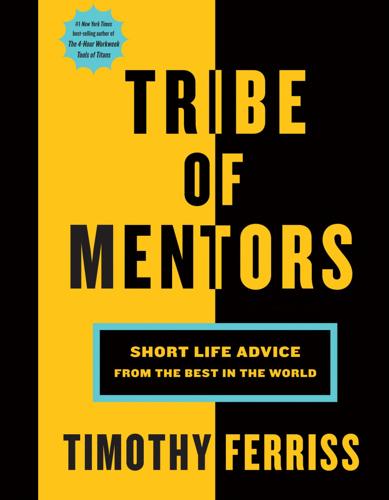
Tribe of Mentors: Short Life Advice From the Best in the World
by
Timothy Ferriss
Published 14 Jun 2017
In 2010, Steve and Jean joined The Giving Pledge and publicly reaffirmed their commitment to give away the majority of their wealth to philanthropic causes. * * * What is the book (or books) you’ve given most as a gift, and why? Or what are one to three books that have greatly influenced your life? The Third Wave by futurist Alvin Toffler had an enormous impact on my life. It was his vision of a global electronic village that helped put me on the path to co-founding AOL. I read Toffler’s Third Wave as a senior in college and was mesmerized by the idea of connecting people through a digital medium. I knew it was inevitable and wanted to be a part of building that future.

The Innovators: How a Group of Inventors, Hackers, Geniuses and Geeks Created the Digital Revolution
by
Walter Isaacson
Published 6 Oct 2014
One aspect of computers he liked was the notion of using them to tap into networks. “The far-away connections seemed magical,” he told the journalist Kara Swisher. “It struck me as the most completely obvious use for them, and the rest was just for computer wonks.”19 After reading The Third Wave by the futurist Alvin Toffler, he became riveted by the concept of “the electronic frontier,” in which technology would connect people to each other and all of the world’s information.20 In early 1980 he applied for a job at the J. Walter Thompson advertising agency. “I firmly believe that technological advances in communications are on the verge of significantly altering our way of life,” he wrote in his application letter.

The Friendly Orange Glow: The Untold Story of the PLATO System and the Dawn of Cyberculture
by
Brian Dear
Published 14 Jun 2017
We celebrate the accomplishments of Xerox’s Palo Alto Research Center, which in turn inspired Apple’s Lisa and Macintosh computers and much of the personal computing environments we still use today. We celebrate the innovations produced by legions of start-up companies and placed into the hands of millions, now billions of people: Innovations that have changed the world. Innovations people cannot imagine living without. We are living in the very “shocking future” Alvin Toffler wrote about—warned us about—forty-five years ago. And the history of how we reached this future has been researched, deciphered, studied, analyzed, organized, and disseminated far and wide for long enough that the story has become legend, set in stone. Nerds, geeks, and hackers are no longer outcasts and ridiculed; they’re now sought-after “thought leaders,” many counted among the tens of thousands of recent millionaires and hundreds of billionaires.

Wired for War: The Robotics Revolution and Conflict in the 21st Century
by
P. W. Singer
Published 1 Jan 2010
Singer, September 19, 2006. 165 “Any sufficiently advanced technology” Arthur Charles Clarke, Profiles of the Future, rev. ed. (New York: Harper & Row, 1973), 21. 165 a magic box that killed almost a thousand spear-armed warriors John Ellis, The Social History of the Machine Gun, Johns Hopkins paperback ed. (Baltimore: Johns Hopkins University Press, 1986), 89. 165 what analysts call “Future Shock” Alvin Toffler, Future Shock (New York: Random House, 1970). 165 “Thereseemsastrongtendency”TimothyHornyak, as quoted in Mark Jacob, “Japan’s Robots Stride into Future,” Chicago Tribune, July 15, 2006, 7. 166 “stems from the fact that doomsday scenarios” H. R. Everett, interview, Peter W. Singer, October 20, 2006. 166 “To be realistic, it’s going to be” Andrew Bridges, “Scientists Aim to Duplicate Harry Potter’s Invisibility Cloak,” LiveScience.com, May 25, 2006 (cited May 25, 2006); available at http://www.livescience.com/scienceoffiction/060525_invisible_cloak.html 166 “And I have no idea” Rod Brooks, interview, Peter W.
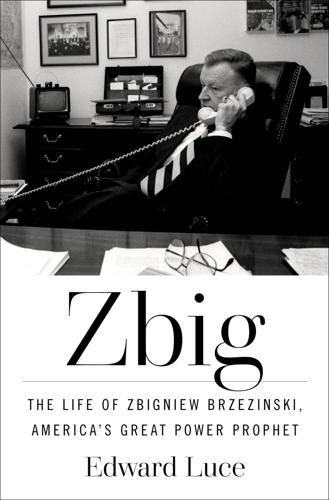
Zbig: The Life of Zbigniew Brzezinski, America's Great Power Prophet
by
Edward Luce
Published 13 May 2025
“The United States has emerged as the first global society in history,” he wrote.26 That was the meretricious part of Brzezinski’s book. He discussed it on television, gave interviews to the big newspapers, and was reviewed in the major publications. Most reviews contrasted his largely optimistic outlook to the dystopia of popular contemporary books, notably Alvin Toffler’s Future Shock, William Braden’s The Age of Aquarius: Technology and the Cultural Revolution, and Nigel Calder’s Technopolis: Social Control of the Uses of Science. Brzezinski’s was notable for its absence of gloom. “One of the most original books on political and social thought to appear in recent years,” wrote Harvard historian John G.

The Atlantic and Its Enemies: A History of the Cold War
by
Norman Stone
Published 15 Feb 2010
It was not surprising that so many Americans felt hostile to the whole process, and a radical, Christopher Lasch, wrote powerfully as to how a bureaucracy-dominating elite had taken power from people to run their own lives. He particularly despised the endless fuss made about cigarette-smoking - it started with a ban in Arizona, in 1973, on smoking in public buildings - but this was a frivolous period, the landmarks down. What Leszek Kołakowski called the politics of infantilism went ahead. Alvin Toffler pronounced in 1970 that the future would amount to endless leisure. For some, it did. In 1970, 1.5 million drew a disability pension, but 3 million in 1980; one tenth of the nation’s families was headed by a single woman, living on welfare. Paul Ehrlich in 1968 looked at The Population Bomb and asserted that there would be famine in the 1970s, and thought that pets should be killed, to save resources.

Palo Alto: A History of California, Capitalism, and the World
by
Malcolm Harris
Published 14 Feb 2023
x Like many of California’s trailblazing laws, this one was contested to the Supreme Court, where a conservative majority upheld the statute on a 5–4 vote. See “Excerpts from Supreme Court Rulings on California’s ‘Three-Strikes’ Law,” New York Times, March 6, 2003. xi Mind Grenades is a fantastic early-internet object. It’s a big picture-book, with out-of-context quotes from futurists like Alvin Toffler and Marshall McLuhan over post-psychedelic visuals. The form is indistinguishable from financial services advertising. One two-page spread reads MONEY IS JUST A TYPE OF INFORMATION, attributed to magazine editor Kevin Kelly. Section V 2000–2020 An Anduril autonomous surveillance camera on the Southern California border United States Customs and Border Protection photo Chapter 5.1 B2K Palo Alto for Bush—The Internet After 9/11—Scrapers Eat the World—Amazon Thrives—The iPod For many years, American cultural and political commentators have advanced theories about why Republicans so strongly disliked Bill Clinton, what made him appear as an existential threat to conservatives.
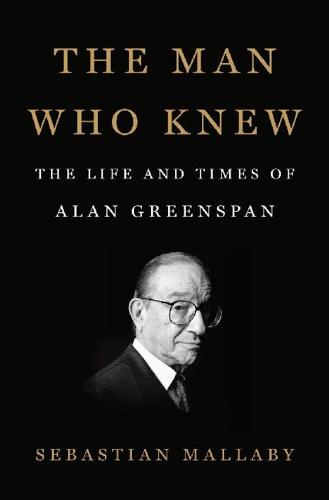
The Man Who Knew: The Life and Times of Alan Greenspan
by
Sebastian Mallaby
Published 10 Oct 2016
Ayn Rand, Atlas Shrugged (New York: Signet Books, 1992), 965. 52. In an interview that appeared that same month in Playboy, Rand insisted that “faith . . . is extremely detrimental to human life: it is the negation of reason.” Ayn Rand, “Ayn Rand: A Candid Conversation with the Founder of ‘Objectivism,’” interview by Alvin Toffler, Playboy, March 1964. 53. Rand argued that objectivists need approve only of Goldwater’s political philosophy, not his total philosophy; a candidate should be expected to represent merely “an approximation” of one’s values, a “lesser of two evils.” Ayn Rand, “How to Judge a Political Candidate,” Objectivist Newsletter 3, no. 3 (March 1964), 10. 54.
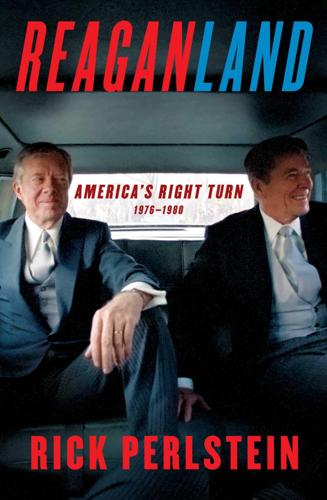
Reaganland: America's Right Turn 1976-1980
by
Rick Perlstein
Published 17 Aug 2020
In suburban Atlanta the unknown was an eccentric history professor who headed Georgians Against the Proposed Panama Canal Treaties. Dr. Newton Leroy Gingrich had had just been denied tenure at West Georgia College for spending too much time on politics. (To cushion the blow, wealthy backers paid him $13,000, structured for them as a tax shelter, to write a novel about World War III. His friend the futurist author Alvin Toffler wrote back after reading a fragment, “You are obviously better at shaking hands than writing fiction.” He never finished the book.) In a speech to a convention of Georgia Young Republicans, Gingrich said, “One of the great problems we have in the Republican Party is that we don’t encourage you to be nasty.